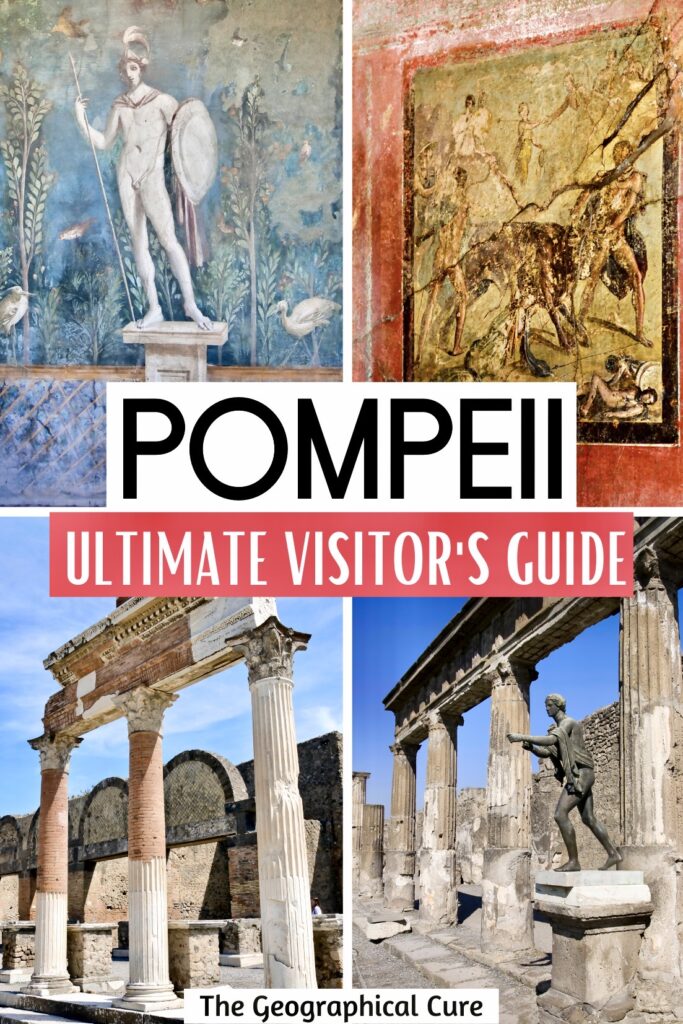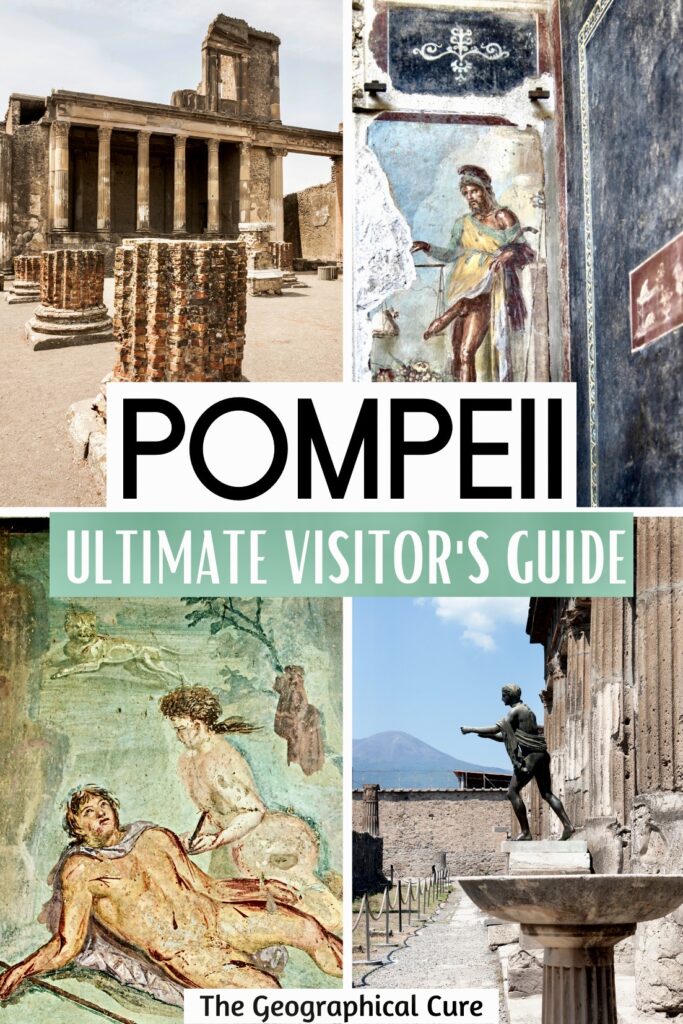Pompeii is a UNESCO-listed archaeological site located just 30 minutes from Naples.
It was once a thriving ancient Roman city. But in 79 A.D., it was tragically buried under layers of volcanic ash and debris when Mount Vesuvius suddenly erupted.
Rediscovered centuries later, Pompeii offers a unique glimpse into the daily life, art, and architecture of ancient Roman civilization.
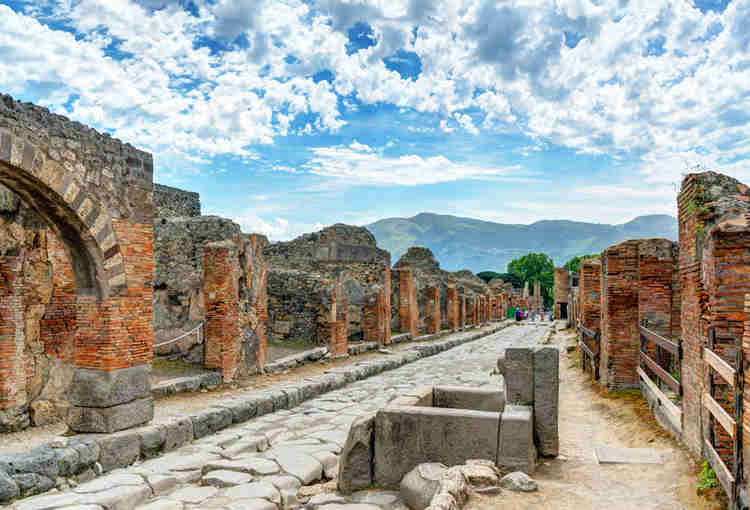
In this guide to visiting Pompeii, I take you on a journey through the streets of Pompeii. I describe 20 of the must see highlights. I also give you essential information, tips, and insights to help make the most of your visit.
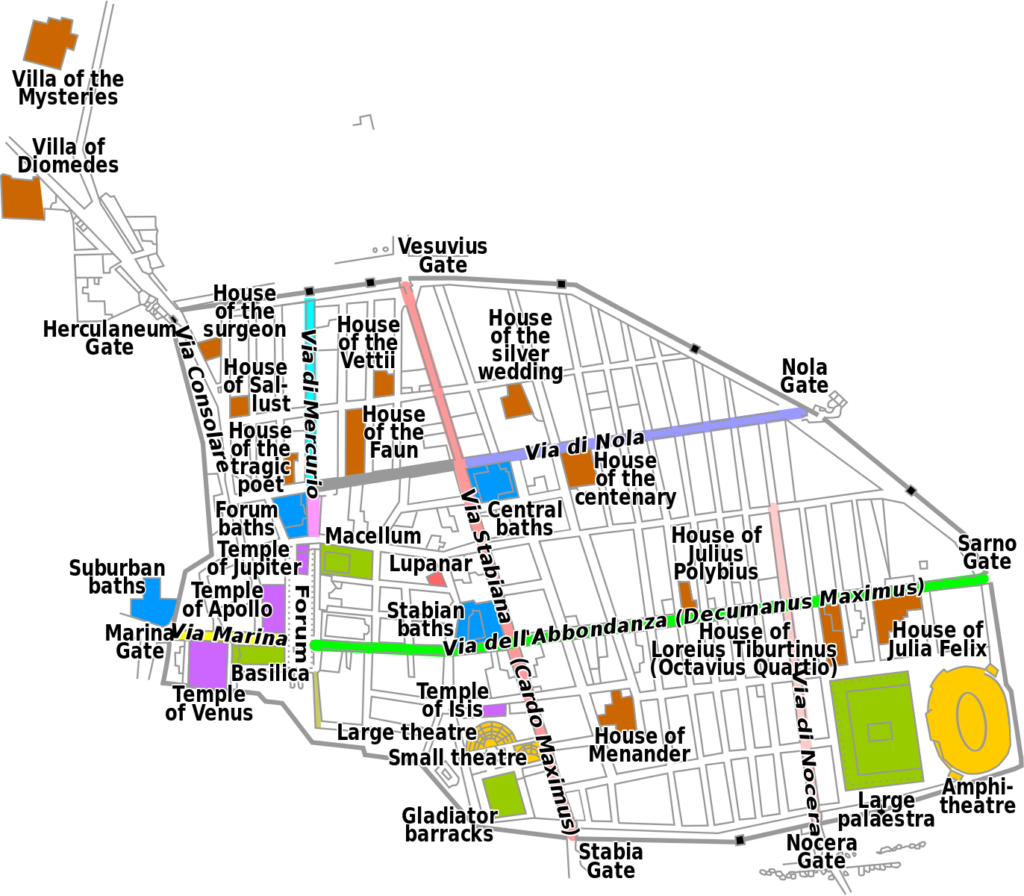
New things are discovered all the time. So, if you’ve been, a repeat visit may be in order.
Tickets & Tours For Pompeii
For a visit to Pompeii, you need to plan ahead. Pompeii is one of the most popular attractions in Italy. You’ll need to book tickets and tours in advance.
Tickets:
When you arrive, there will be two lines: one for people with tickets and one for people who need to buy tickets.
Unless you’re visiting in the winter, I would be sure to book a skip the line ticket in advance. Even then, you will have to wait in line for awhile just to get through. Be sure to grab a map when you enter.
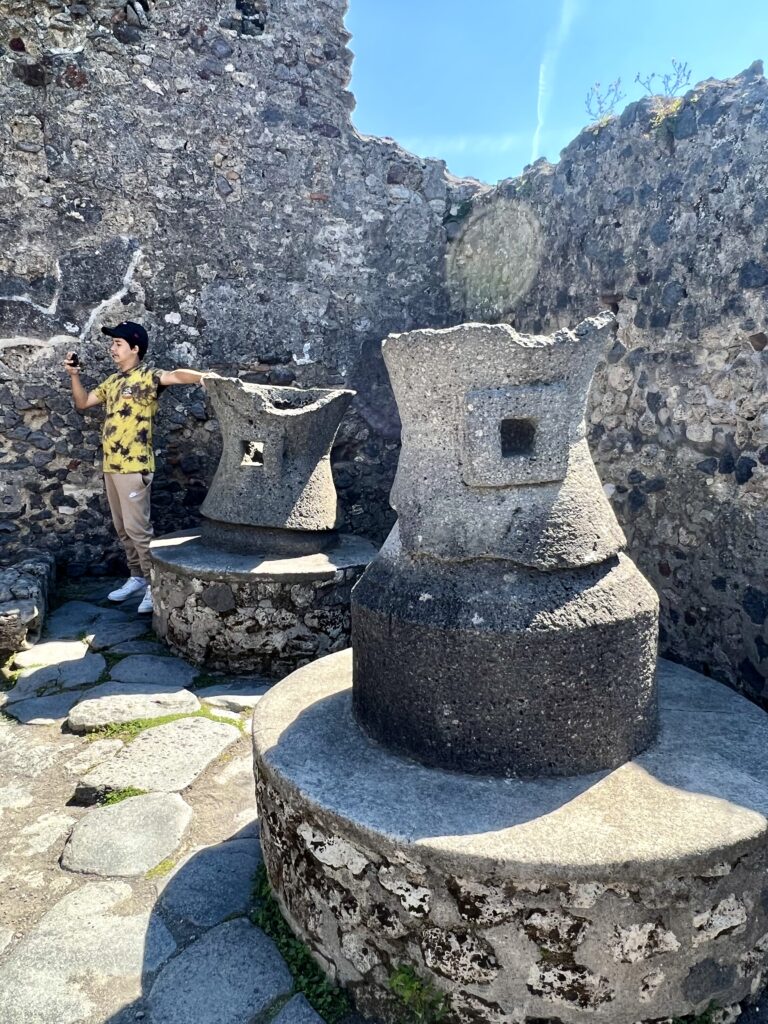
Should You Book A Guided Tour?
Unless you’re a Romanologist or just prefer to roam on your own, I recommend booking a guided tour with an expert. Pompeii is a complicated site and there’s a lot to see.
You can have a more relaxed visit with an expert. Plus, they will take care of obtaining tickets.
Having a guide is especially important if you have limited time in Pompeii. A tour guide will get you to the main highlights in a fast and efficient way.
Over the years, I’ve visited Pompeii three, by myself twice and once in a small group. This time I booked a private tour and was glad I did. There were just so many newly renovated sites to see in Pompeii.
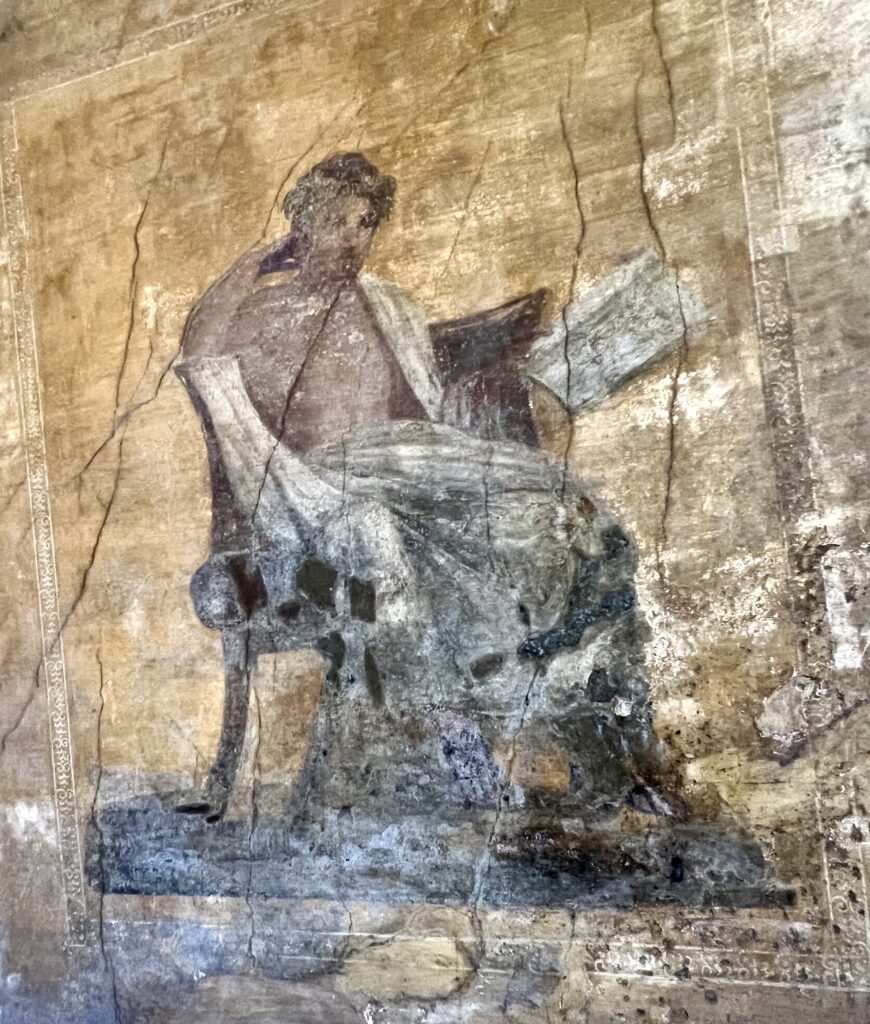
Having a guide has some decided advantages. First off, our guide pulled us straight through the rather long line at the entrance for tickets and a security check.
With a private tour, you can also select the sites that you want to see most. For example, this time around, I really wanted to see the newly-renovated frescos at the Villa of Mysteries and the recently-opened House of the Vettii.
But they aren’t on any standard tour because they’re outside the center (Vettii) or in the “suburbs” (Mysteries).
You should also consider the length of the tour when booking one. Almost every tour lasts 2 hours. If that’s all you have, try to book a tour with an archaeologist to get the most bang for your buck.
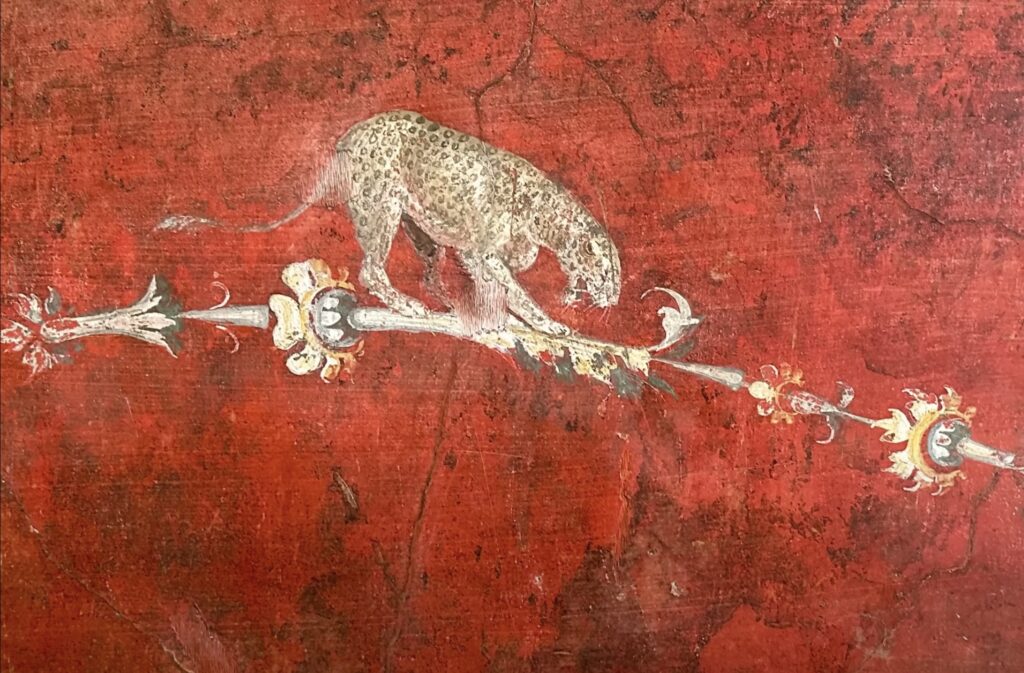
You can only skim the highlights of Pompeii in 2 hours. Depending on your expectations, you might come away a tad unsatisfied. But you can always stay longer after your tour is over, if time permits.
I had a friend who recently visited and was disappointed not to see more frescos. But that’s the thing. Most of them are not on a standard tour.
Here are some tours you might consider booking that are 3+ hours:
- 3 hour private tour with an archaeologist
- guided tour tour from Naples of Pompeii and Herculaneum with an archaeologist
- 6 hour private tour of the Pompeii and the Naples Archaeological Museum
- 10 hour private tour from Rome
You can also arrange a guide at the main entrance of Porta Marina.
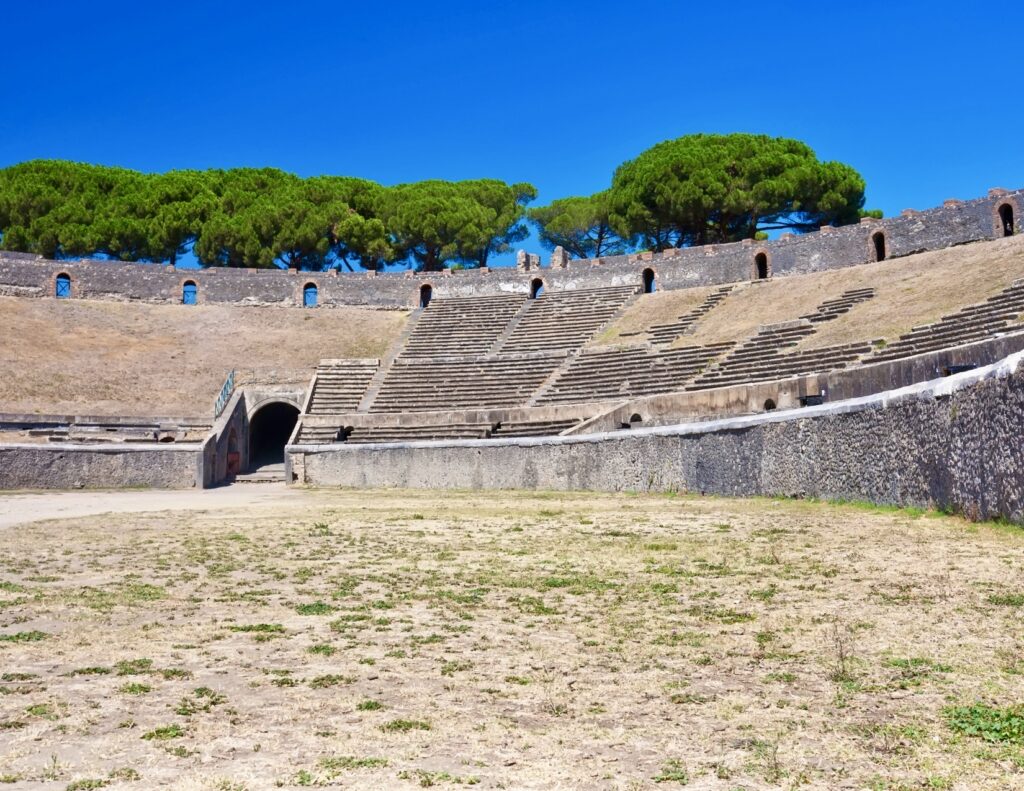
Guide To Pompeii: 20 Things To See
Here are the 20 best and most important things to see in Pompeii.
1. Amphitheater
While not as grand as the Colosseum in Rome, Pompeii’s well-preserved amphitheater dates from 70 B.C. It could seat up to 20,000 people and was one of the largest Roman amphitheaters of its time.
The amphitheater is a large oval building. It was built to host gladiatorial games, animal hunts, and other spectacles.
The brick exterior is characterized by a series of arches or arcades. They form a continuous ring around the outer walls. They served as entrances and exits for the spectators and helped facilitate crowd flow.
As with the Colosseum, the seating was divided into different sections based on social class. There was also an underground area, called the hypogeum, where gladiators prepared for the games.
READ: Guide to the Colosseum in Rome
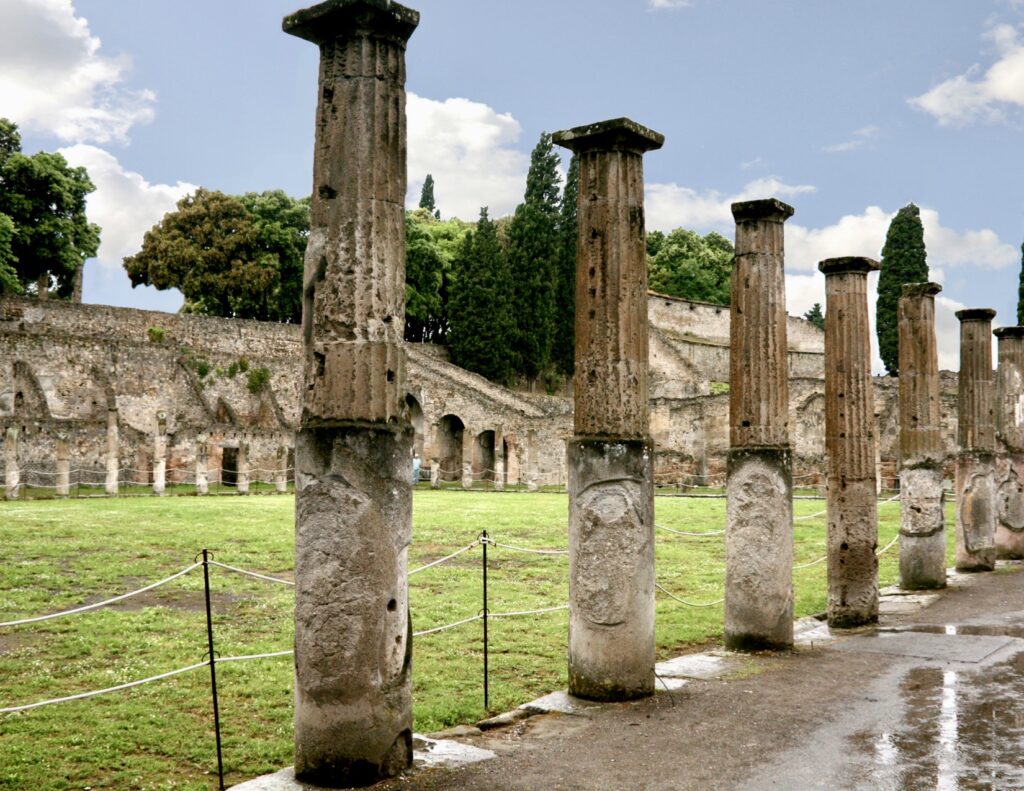
2. Great Palestra
Right next to the amphitheater, this “great palace” was the gymnasium of the gladiators. It’s a large rectangular open-air courtyard that served as a training ground for gladiators and athletes during ancient Roman times.
The central courtyard is surrounded by porticoes where the gladiators would rest during training sessions.
The courtyard itself was used for various physical activities, including combat training, wrestling, and exercises to improve strength and agility.
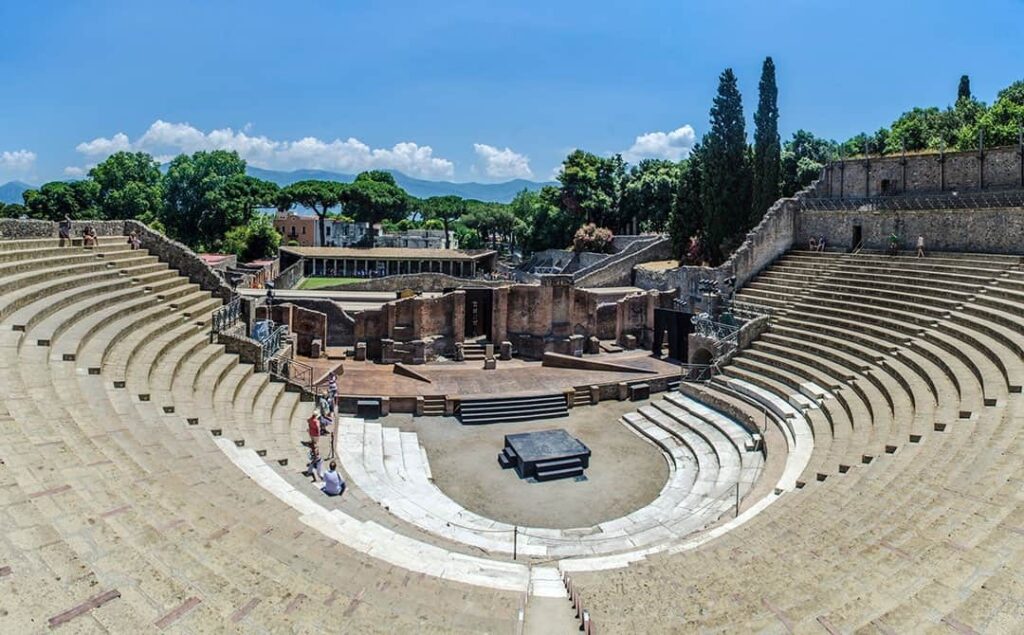
3. Teatro Grande
Once covered in marble, Teatro Grande was Pompeii’s second largest theater. It had seating for 5,000 people. It was essentially the “Broadway” of Pompeii.
The theater hosted musicals, Greek tragedies, comedies, and other dramatic performances. It was conveniently located next to the fast food joints, so citizens could get a quick meal before or after show time.
You should climb to the top of the seats for views of the ruins.
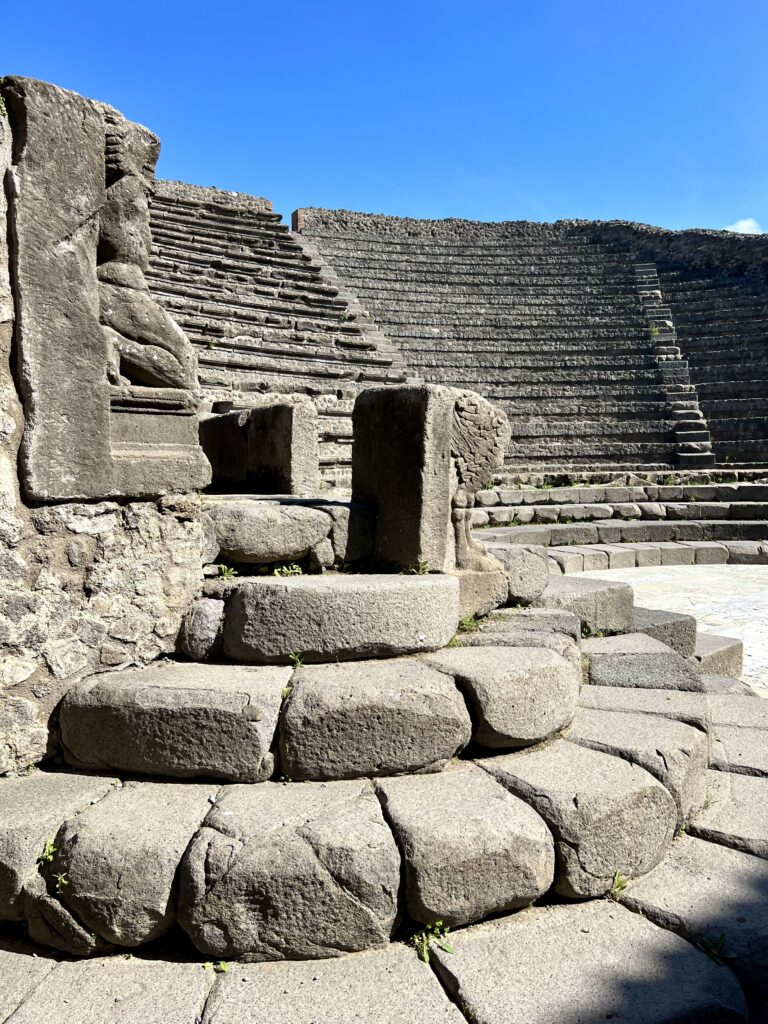
4. Teatro Piccolo: Odeon
Teatro Piccolo was the smallest of Pompeii’s three theaters. Dating from the 1st century B.C., it was an intimate venue with only 800 seats.
It once had a domed roof and remarkable accoustics.
The theater hosted musicals. It was likely used for special performances for the aristocracy.
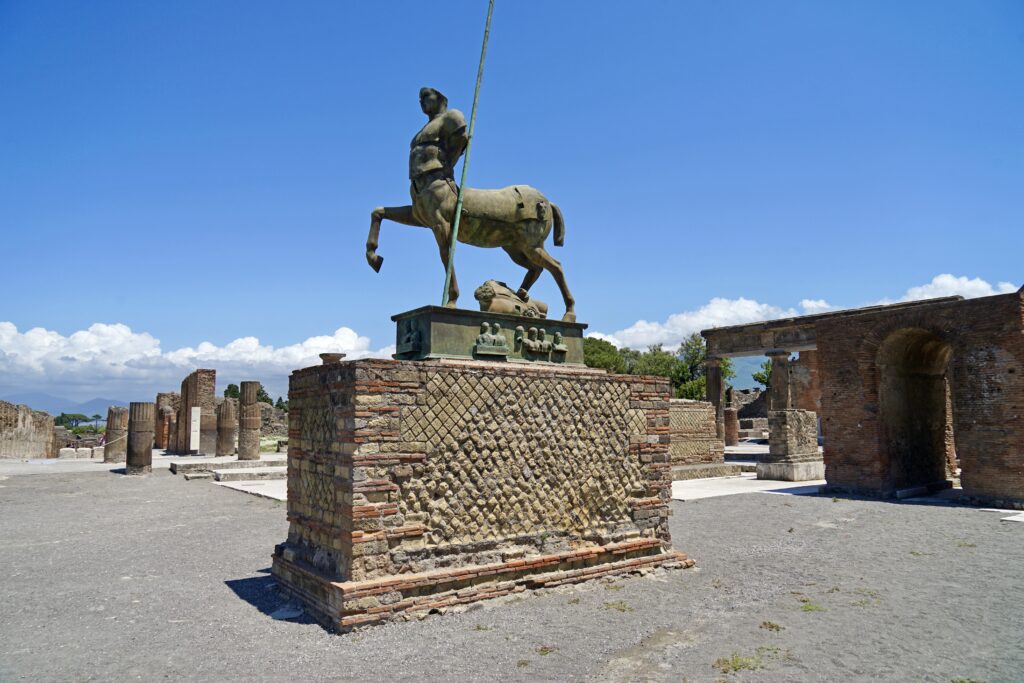
5. Forum of Pompeii
As with every Roman town, the forum or foro was Pompeii’s main square. A colonnade with loggias ran along three sides. You can see Mount Vesuvius looming in the distance.
The two triumphal arches you see are from the Temple of Jupiter. He was the chief god in the Roman pantheon of gods.
In the forum, you will also find the ruins of a wool factory and a covered meat and fish market.
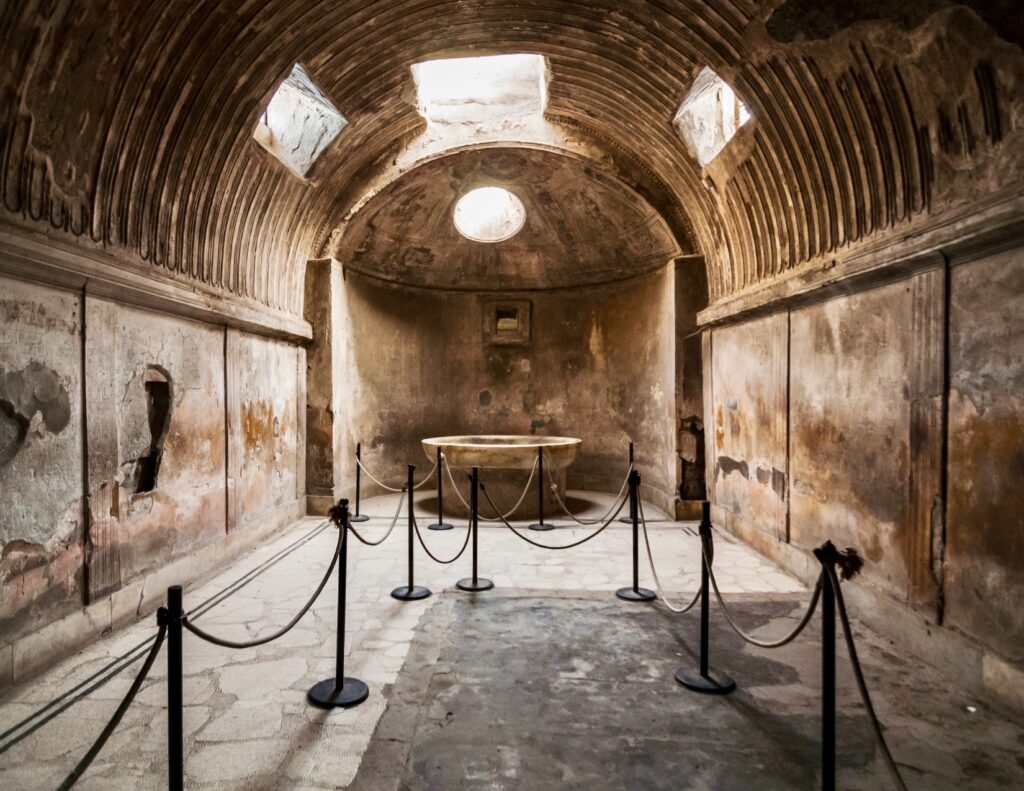
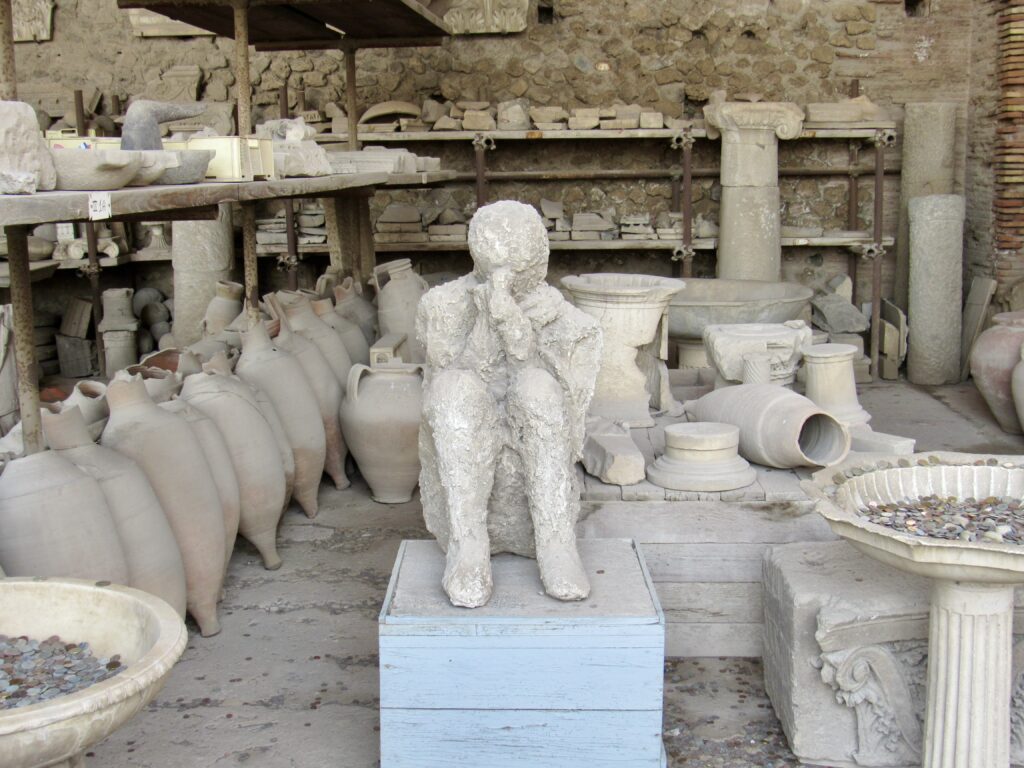
The forum was also home to some large baths. There was a changing room, frigidarium, tepidarium, and caladium. Like most Roman baths, the caladium had a hypocaust system, or underfloor, heating system.
The baths were once adorned with beautiful frescos and marble decorations. It was also home to a library, gymnasium, and shops.
The forum granaries house a vast collection of over 9,000 artifacts unearthed during excavations. You’ll see vessels, terra cotta pottery, and amphorae jars.
You’ll also come face to face with Pompeii’s victims when you see the haunting plaster casts. This is where you will see the poignant cast of a man who tried to cover his mouth to prevent toxic gases from getting in.
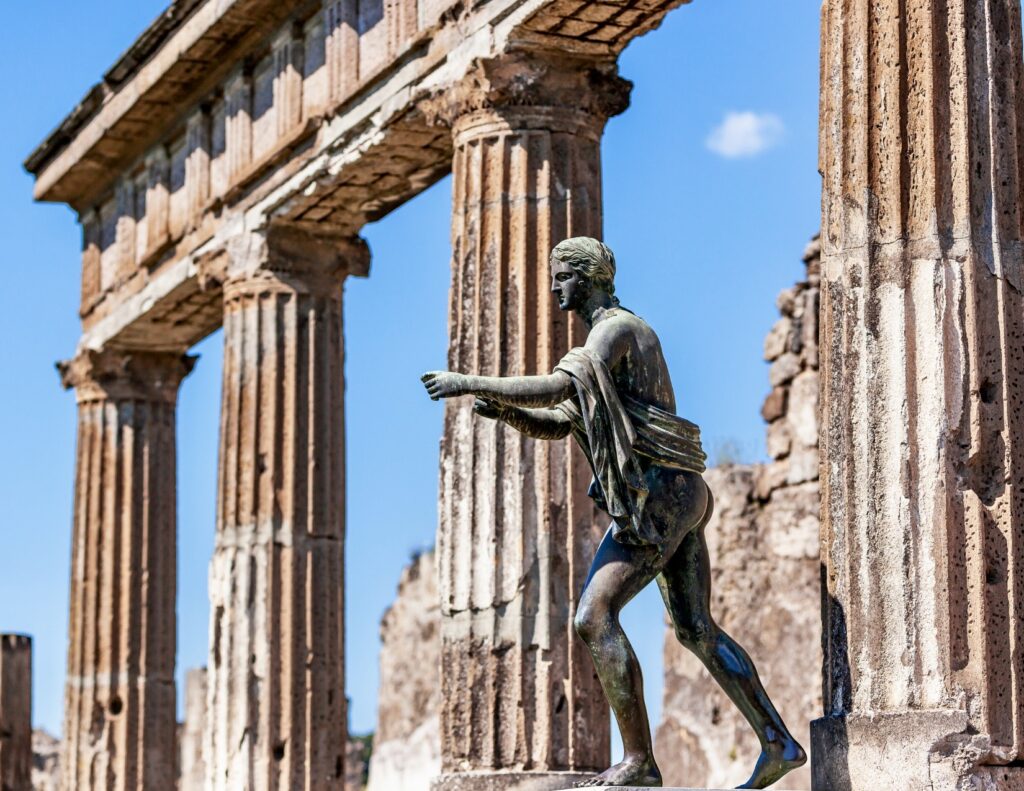
6. Temple of Apollo
The forum’s Temple of Apollo is Pompeii’s oldest religious building. It has a fairly standard design with a portico and pediment support by Corinthian columns.
It was once used for religious ceremonies and festivities dedicated to the cult of Apollo. Statues of Apollo from the temple are now housed in the Naples National Archaeological Museum, with many of the other treasures from Pompeii.
Just to the right of the temple is the Basilica. It was once home to the law courts and public offices.
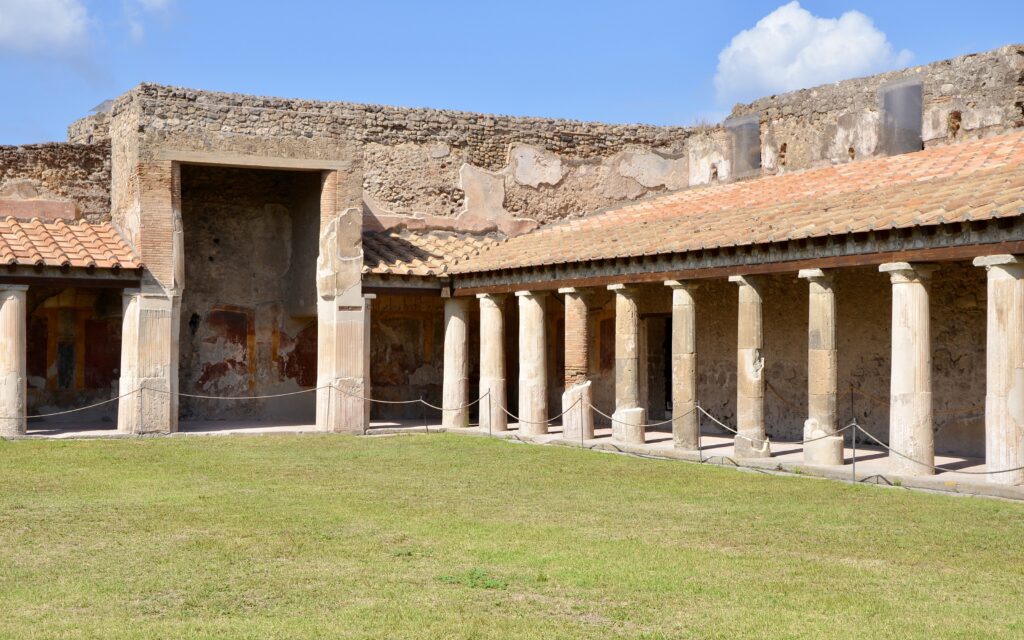
7. Stabian Baths
The Stabian Baths are the oldest and largest bath complex in Pompeii. They were named after the Stabian Gate, which is located nearby.
The baths are a large complex with several different sections.
They consist of a vast central courtyard surrounded by various rooms and chambers: changing rooms, hot and cold baths, saunas, and exercise areas.
READ: Guide to the Baths of Caracalla
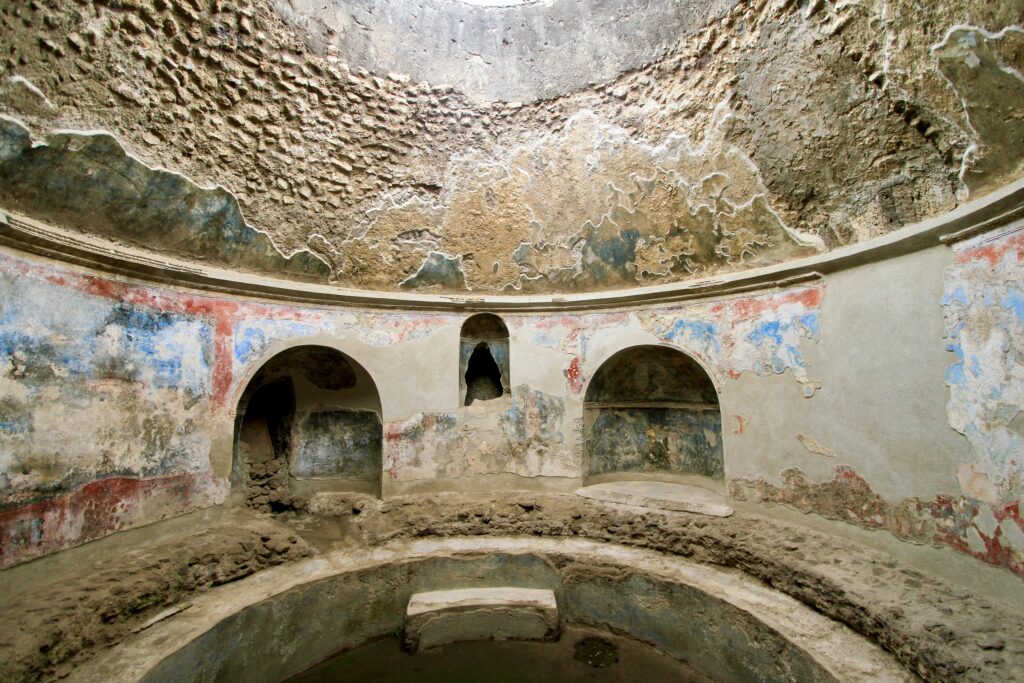
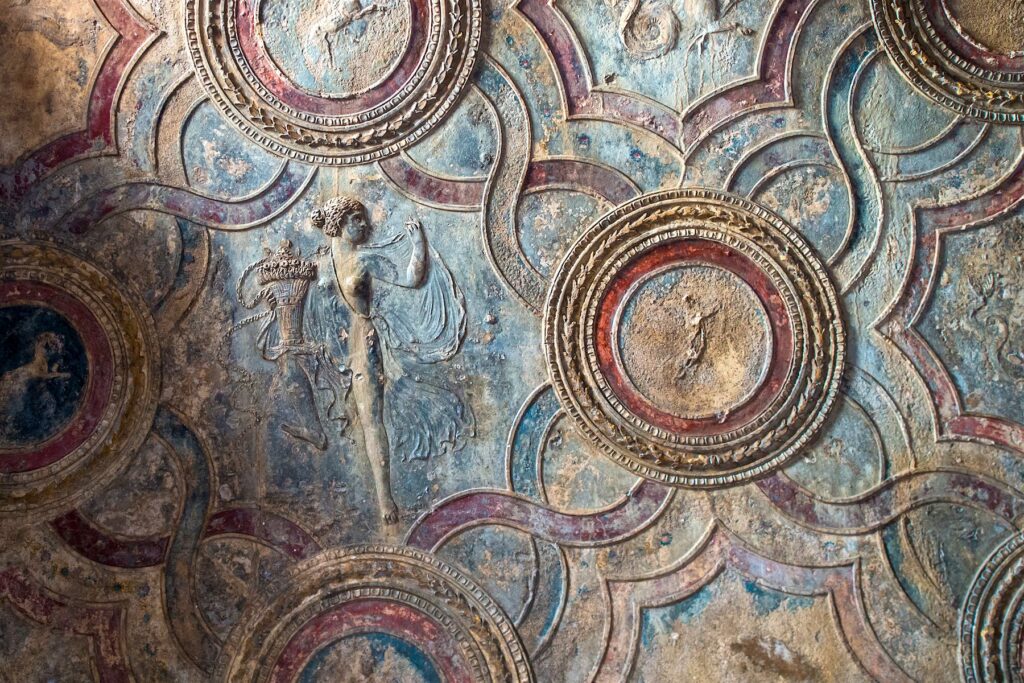
Like all Roman baths, the baths served as an important social and cultural hub, They were a place for relaxation, socializing, and maintaining personal hygiene.
The baths were once adorned with beautiful frescoes and mosaics that depict scenes from mythology, everyday life, and nature. Some remnants of them remain on the walls and ceilings.
The stucco decorations are particularly impressive. There are a range of pigments in blue, yellow, red, and green. They were intended to add an air of opulence to enhance the bathing experience.
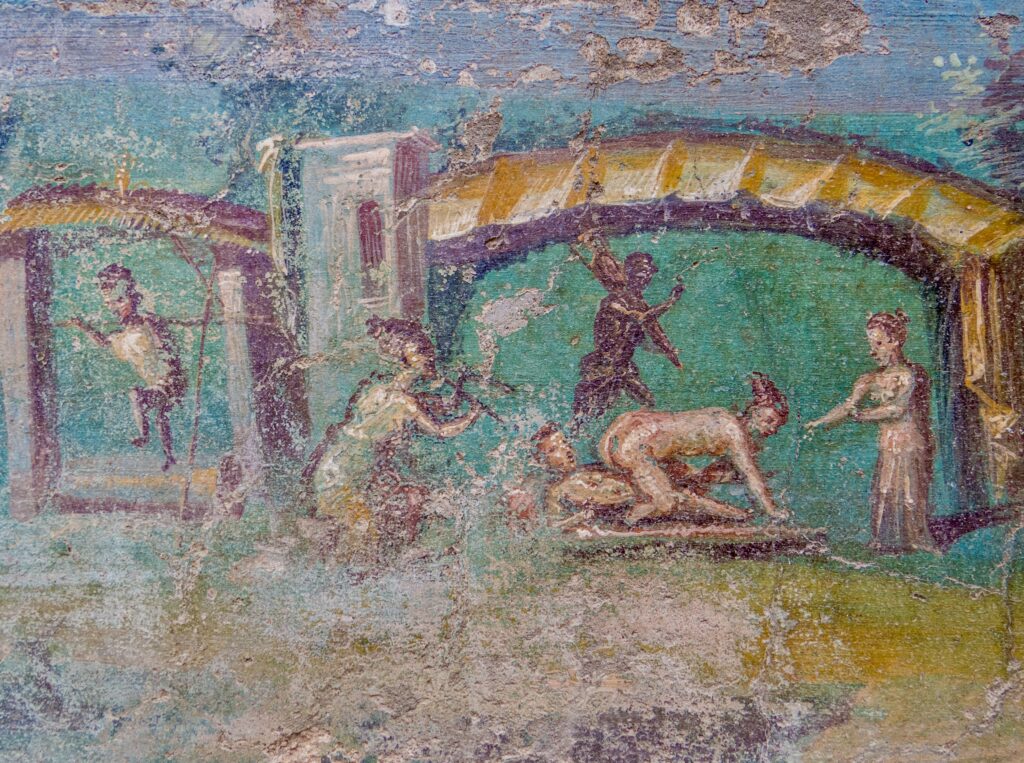
8. Brothel
It’s estimated that there were between 25-35 brothels in Pompeii. The main one to see is Vitolo del Lupanare just off the main drag (Via dell’Abbondanza).
You will know you’ve arrived when you see a penis marked in the pavement. This is one of the most popular attractions in Pompeii. Prepare for crowds and lines.
Frescos above each doorway indicated the specialty of each prostitute. In Ancient Rome, prostitution did not carry a stigma. It was part of everyday life.
If there is a long line to enter the brothel and you don’t have much time, I would recommend skipping it. The brothel is rather basic and definitely not worth a long wait. There are better sites to see in Pompeii.
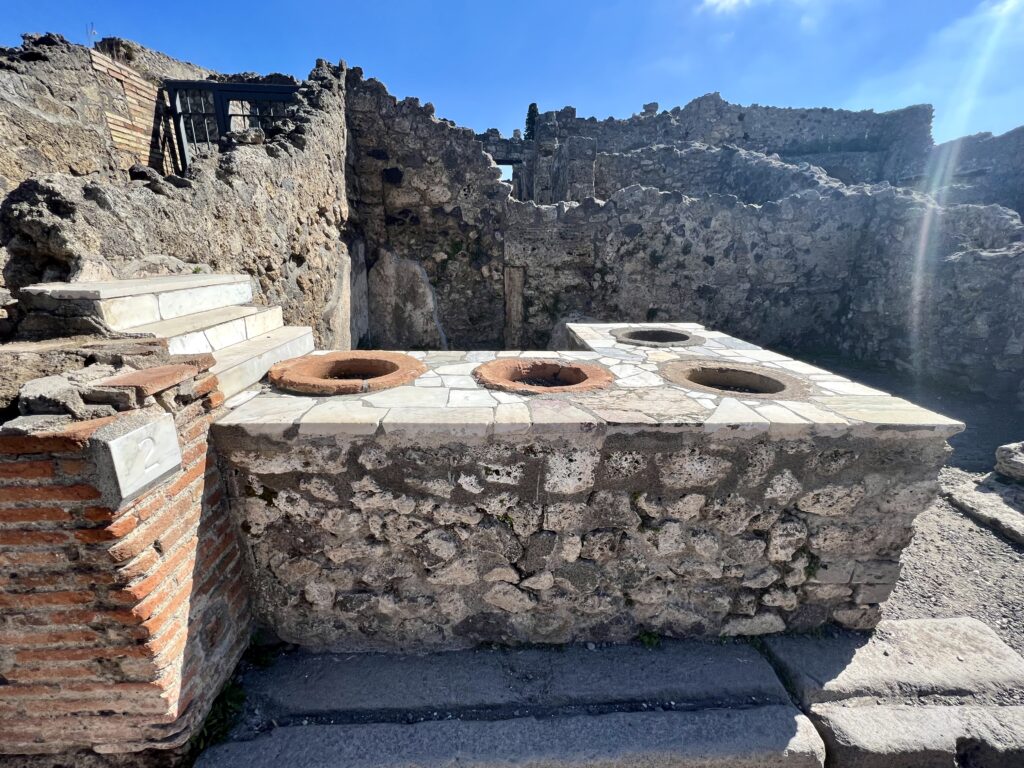
9. Fast Food Stands
Pompeii had over 80 fast food kiosks. The remains show that takeaway culture was an essential aspect of Roman life.
The fast food stands known as thermopolia. They were popular places for the ancient Romans to grab a quick meal or snack.
A thermopolium consisted of a counter with openings (called dolia)where containers or jars filled with food and beverages were displayed. The food offerings typically included items like stewed meats, marinated fish, cheese, and vegetables.
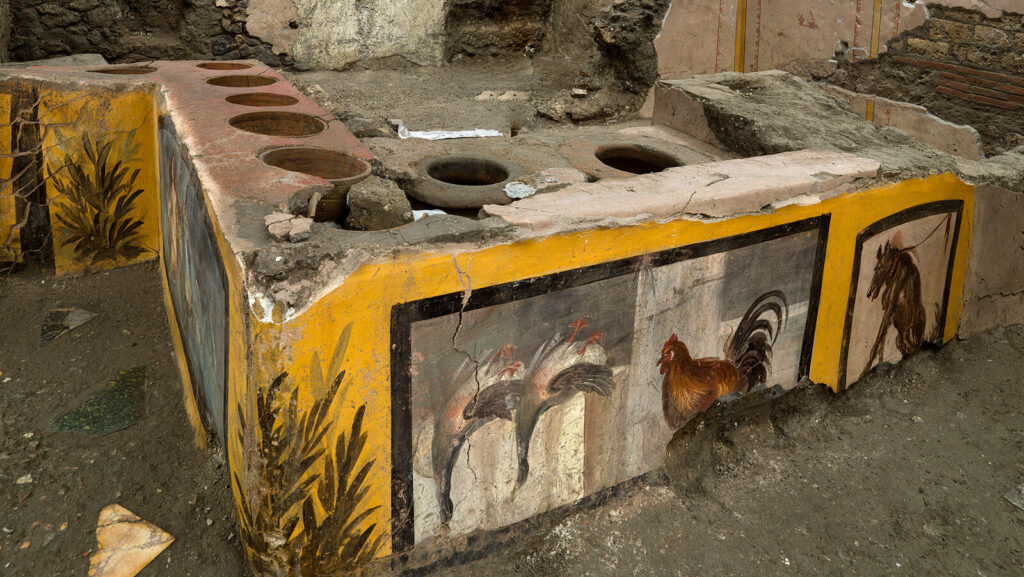
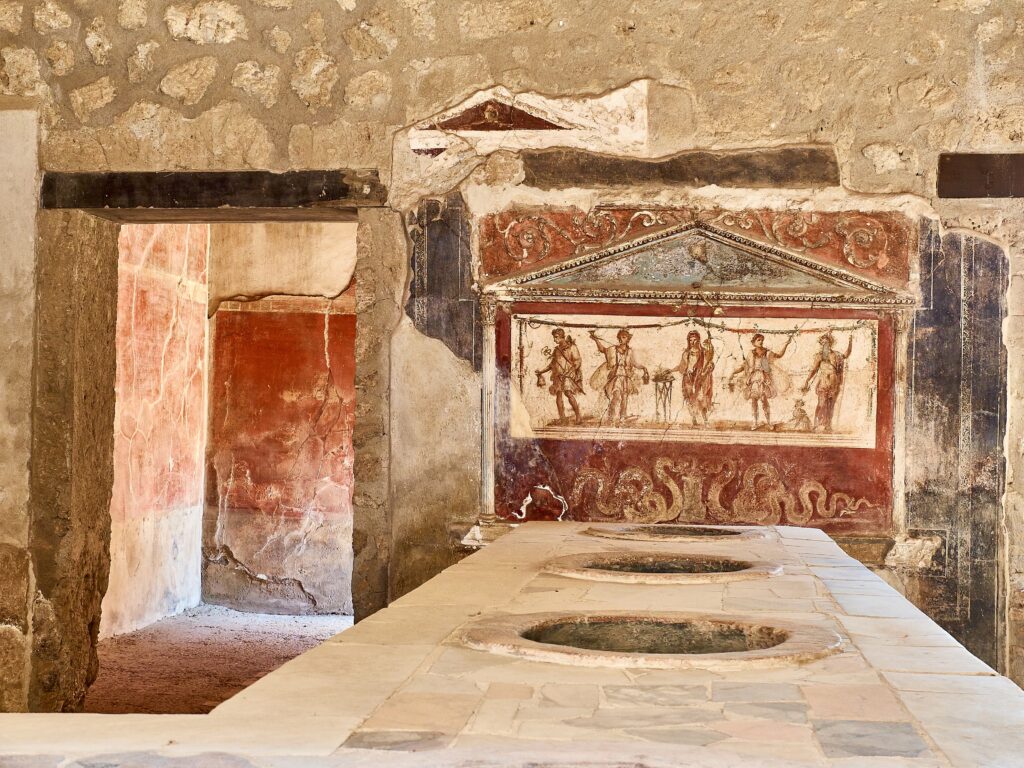
The food in the thermopolia was usually prepared in advance and kept warm in pots or pans placed in hot water or on hot coals. Customers could enjoy their meals standing at the counter or take them away in clay or ceramic containers.
In 2019, a richly decorated thermopolium was discovered in Region 5. It opened to the public in August 2021.
The thermopolium had a multi-sided counter. The counter was covered with fresco decorations, including a dog on a leash, geese, and an undersea nymph riding a horse.
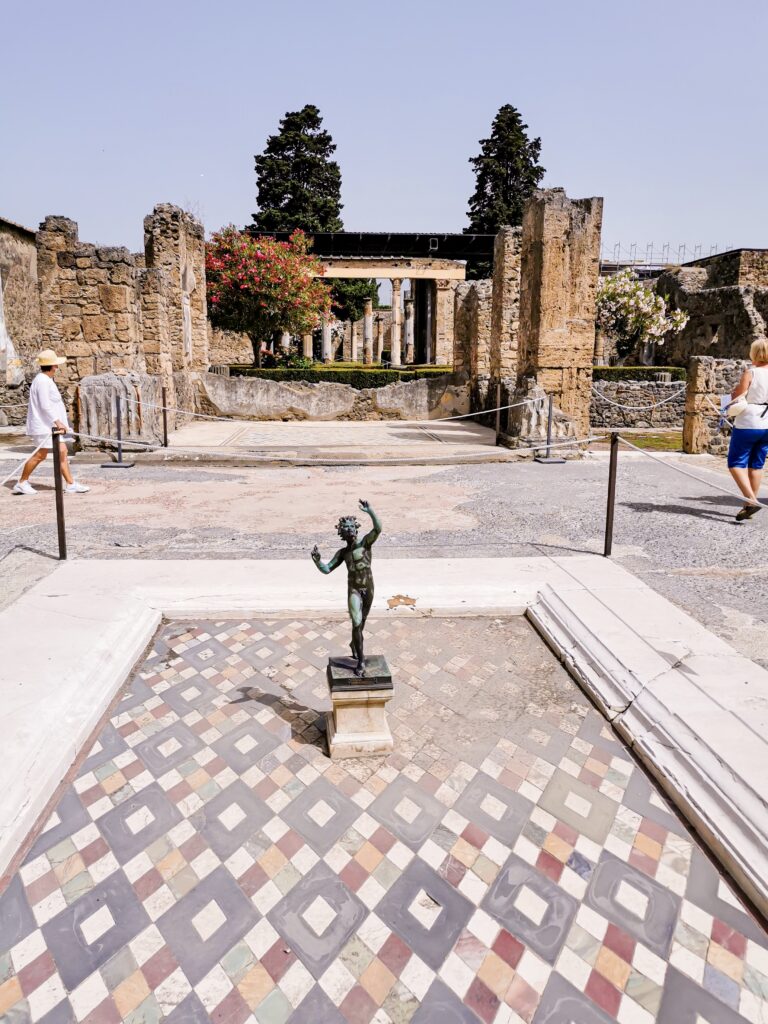
10. House of the Faun
You won’t find any frescos in the House of the Faun, but you should still make a quick visit for its architectural grandeur. It was the largest and sophisticated domus in Pompeii. It took up an entire city block.
It has two inner courtyards, rather than the usual single one. There were also four dining rooms, or triclinia, one for each season.
The House of the Faun is most famous for the huge cache of ancient tessare mosaics found there, which are now in the Archaeological Museum.
Indeed, it was home to the most impressive mosaic from Ancient Rome — the Alexander Mosaic, from the 2nd century B.C. The mosaic depicts a battle between the armies of Alexander the Great and King Darius of Persia.
The original mosaic, which is currently being restored, is in the Naples National Archaeological Museum. But there has been an exact reproduction onsite since 2005.
11. House of Menander
The House of Menander is one of the most famous and well-preserved residences in Pompeii. It’s right in the center, so you can’t miss it.
The house is named after a Greek dramatist whose portrait was discovered within its walls. This grand house was owned by a wealthy and aristocratic Pompeiian family.
The large house has intricate frescoes, colorful mosaics, and exquisite architectural details. Its layout consists of multiple rooms, including a central atrium, a peristyle garden, dining areas, and living quarters.
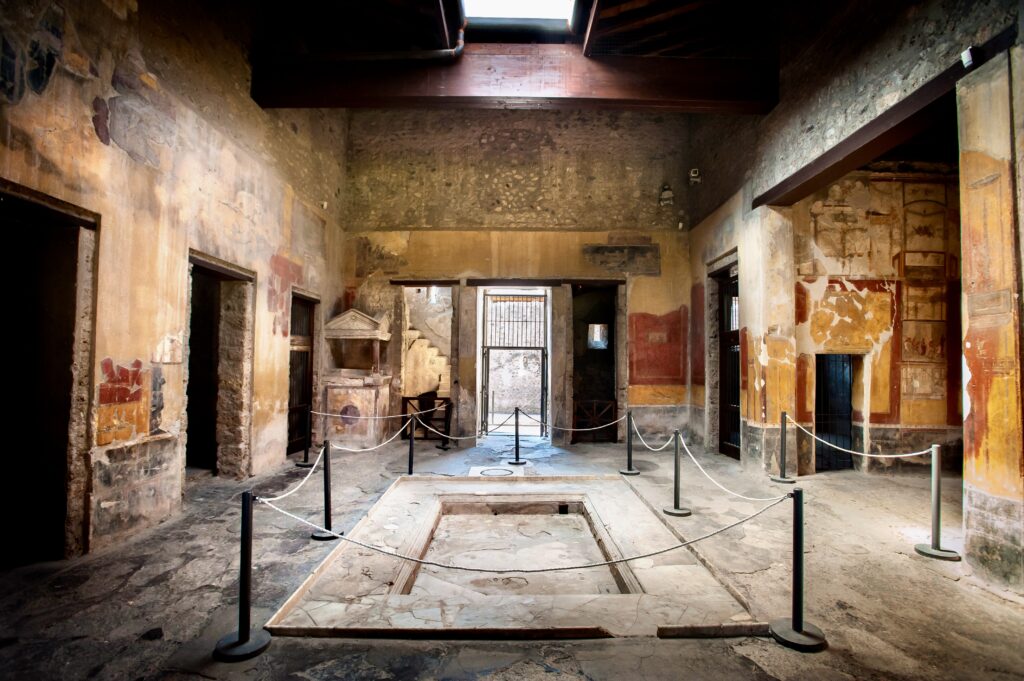
This house is where you’ll find some of the best in situ frescos in Pompeii.
They depict mythological scenes, landscapes, and intricate architectural elements, showcasing the artistic mastery of the time. One mosaic depicts grotesque pygmies on the Nile, which was inspired by the Roman conquest of Egypt in 30 B.C.
One of the highlights of the house is the large triclinium, or dining room, where elaborate banquets and social gatherings would have taken place.
The atrium features a beautiful impluvium, a sunken pool that collected rainwater. It’s home to scenes from the Iliad and the Odyssey.
In an underground corridor of the building, archaeologists discovered a 118 silver set that is now in the Archaeological Museum.
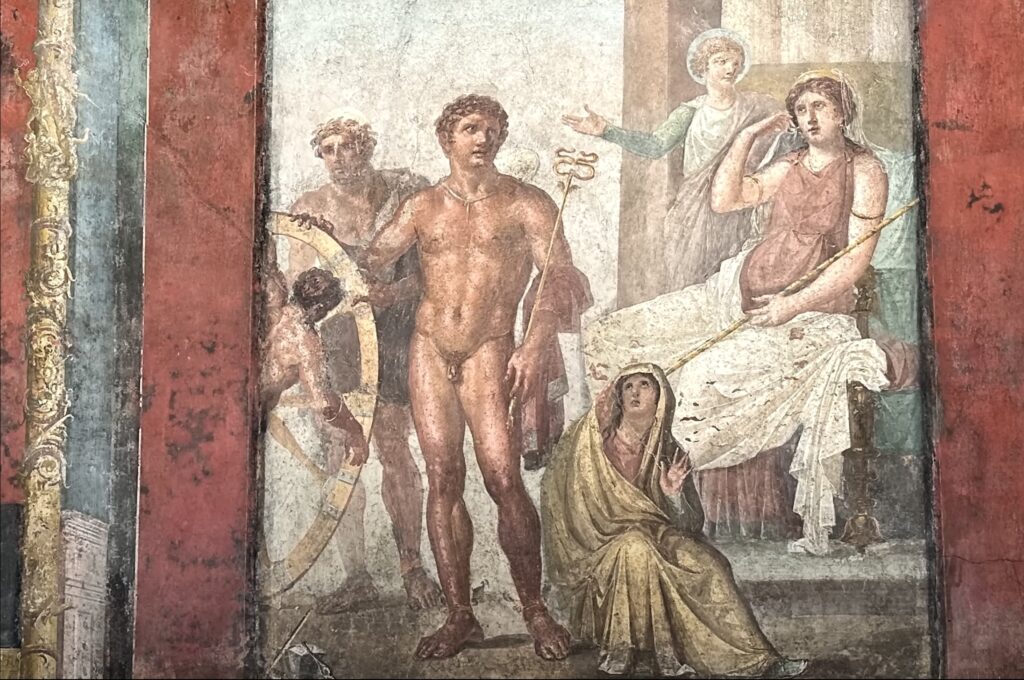
12. House of the Vettii
The House of the Vettii just reopened to the public in January 2023 after 2 decades of restorations. I’m so glad that I could see it!!
The house was renowned in ancient times for its mythological frescos and statuary. It was owned by two brothers, who were former slaves, from the Vettii family. They hit the jackpot in the wine trade and spent lavishly on their home.
At over 11,000 square feet, it was one of the largest houses in Pompeii. Right now the restored frescos are still in situ.
When you walk in through a red reception hall, you are immediately greeted by a fresco of the minor god Priapus. He’s weighing his mammoth member on a scale against a bag of gold.
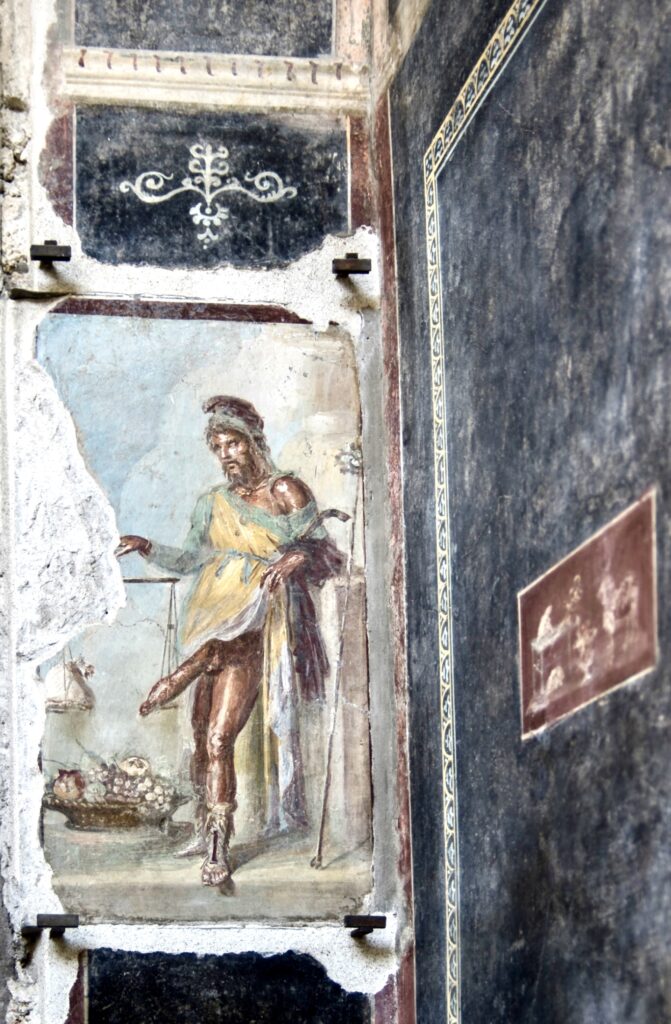
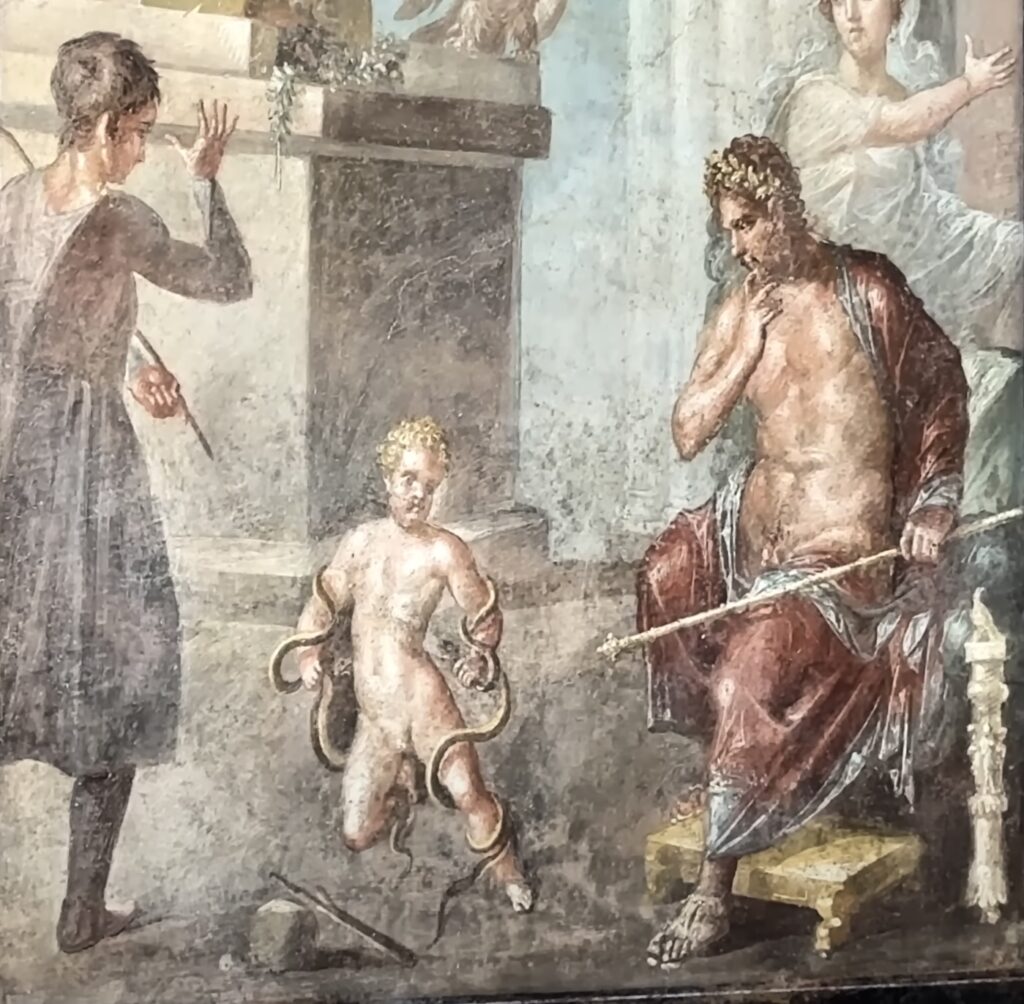
It’s an image you likely won’t forget. Yet, phalluses were ubiquitous in Roman life. They represented wealth and fertility and also warded off the evil eye.
The main dining room has the best preserved frescos, with images of Jupiter. There’s a remarkable frieze of tiny cupids wrapping around the room. They are depicted performing everyday tasks of daily life at the time.
In another small dining area with yellow frescos, you’ll see a fresco of a baby Hercules strangling some snakes. In the outdoor peristyle is a marble statue of Priapus (also enormous).
13. House of the Mysteries
From the House of the Vettii, you can make your way to the Villa of the Mysteries. It’s outside the city walls in the suburbs of Pompeii.
The house dates from 100 B.C. But its current layout is from 70 B.C. when it changed ownership.
The domus is an astounding place. The dining room boasts one of the best preserved pictorial cycles from antiquity. They are partly lit by natural light through two windows.
The large scale frescos are thought to depict a young girl, possibly a bride, being initiated into the mysteries of the secret Dionysian cult. Since the cult was a secret religion, the practices were mysterious and hence gave the house its name.
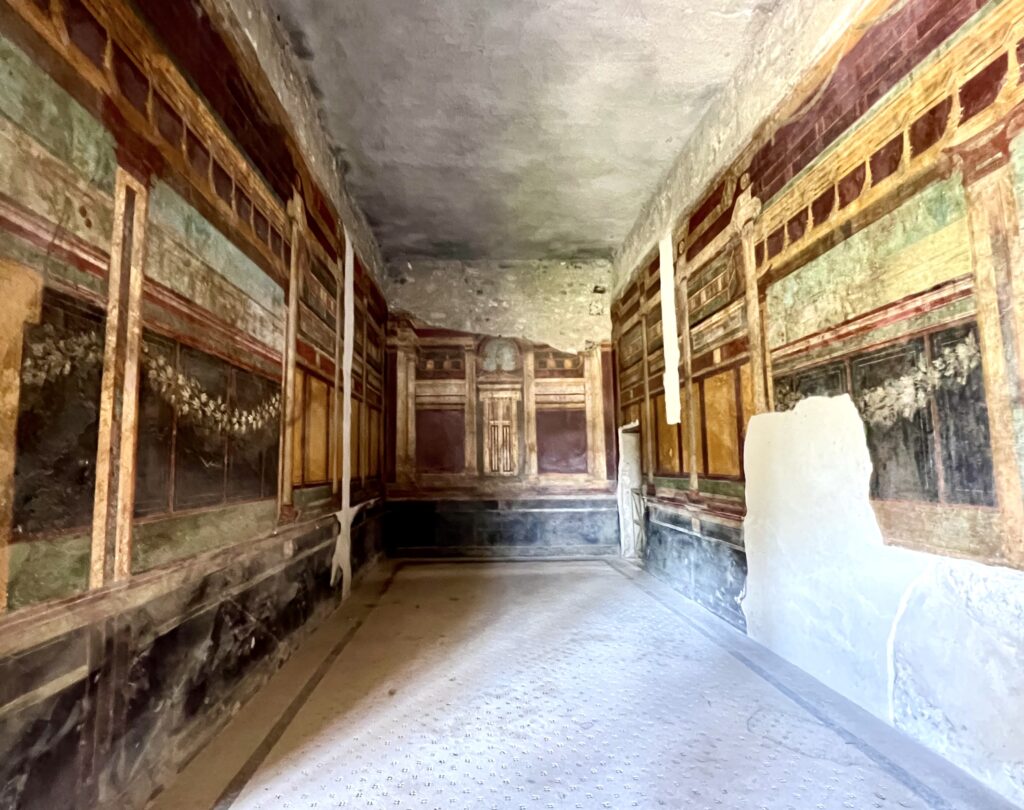
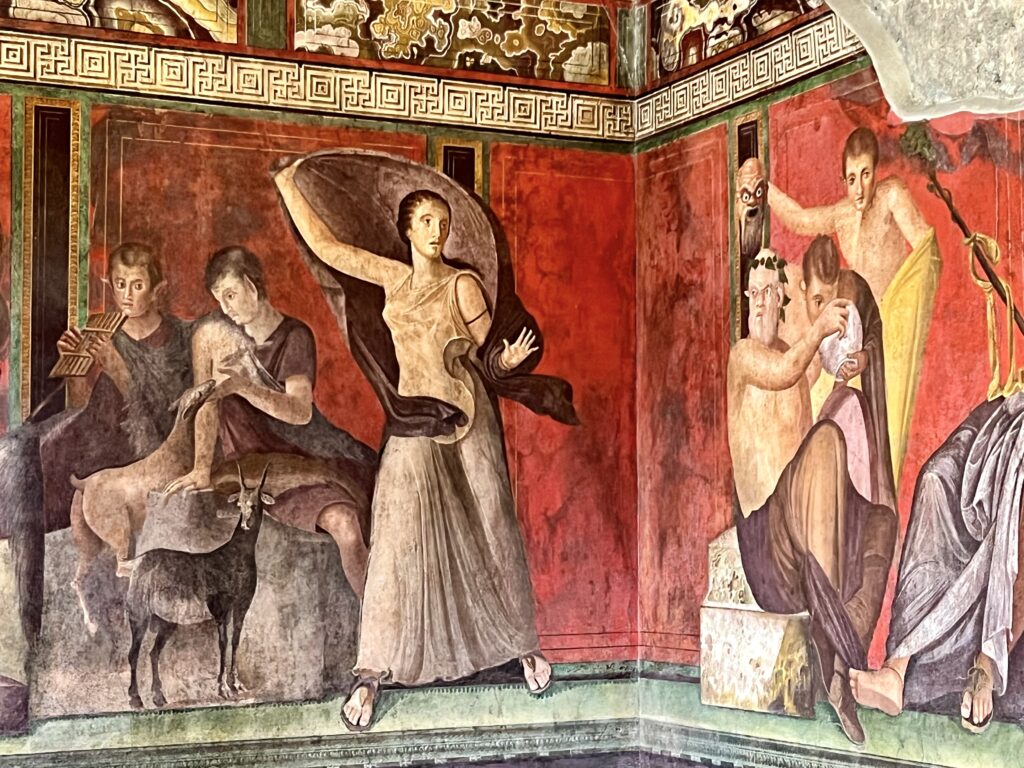
The scenes unfold across along three walls in a large room known as the Initiation Chamber.
The frescos are filled with symbolic and allegorical imagery. Dionysus (who looks tipsy) and his followers are depicted in vivid colors, dynamic poses, and ecstatic revelry. There are beautiful reds, greens, purples, and blues.
The exact meaning of the fresco is still disputed among scholars. Some think they are mere decoration or a more personal narrative depiction of the girl. Or perhaps just deal with the more general theme of female initiation.
There are also other rooms with second style Pompeiian wall paintings, which contain architectural decorations. All the frescos were restored between 2013-15 in an almost $1 million renovation and they are very vibrant.
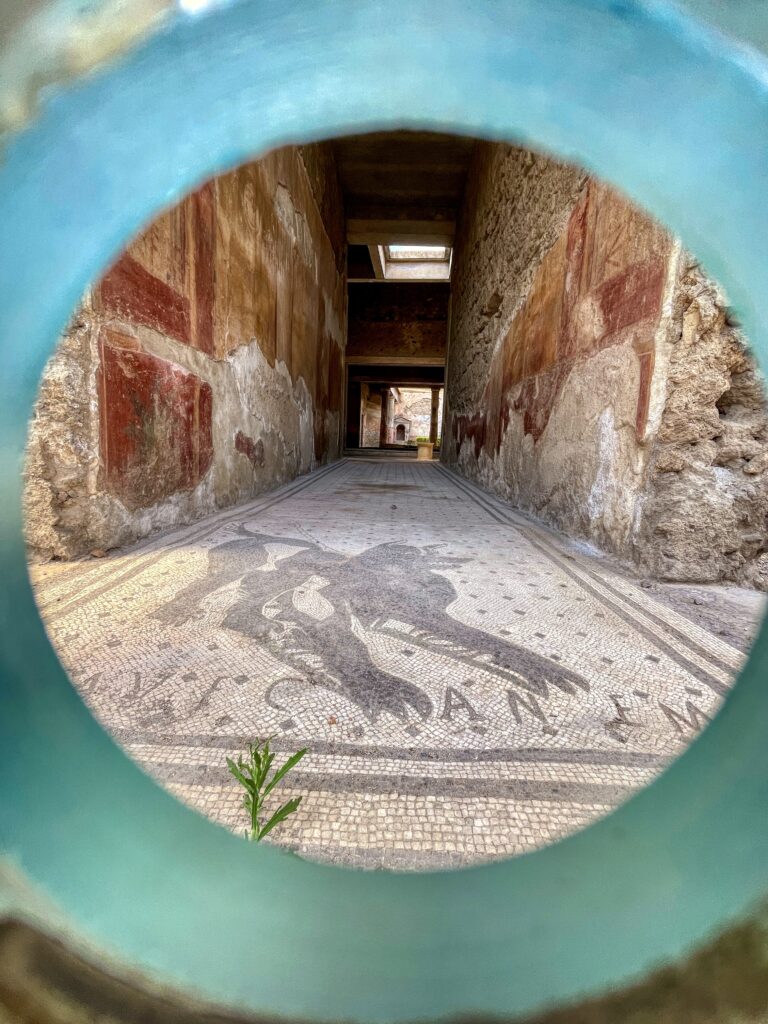
14. House of the Tragic Poet
The House of the Tragic Poet is is a centrally located house just opposite the Forum Baths and is worth a quick peak (if it’s open). It’s smaller than the other grand houses in Pompeii, so you can see how the middle class lived.
Its name comes from a famous mosaic depicting a poet and his troupe rehearsing a play. You can see that mosaic is in the Naples Archaeological Museum.
The atrium of the house was once decorated with six large frescos illustrating scenes from the Iliad.
Today, the domus is famous for its mosaic at the entrance, which is still in situ. It’s a floor mosaic of a fierce chained dog. It comes with a warning Cave Canem, beware of the dog.
15. House of Venus In The Shell
The House of Venus in a Shell is a well-known house in Pompeii named after a fresco found onsite. The house is notable for its exquisite frescoes, intricate mosaics, and architectural elements that depict scenes related to the goddess Venus.
The most famous decorative element is the large fresco of Venus rising from a shell, which is located in the peristyle area. This iconic depiction of Venus, known as the Birth of Venus, is a beautiful example of ancient Roman art.
The house also includes other frescoes portraying mythological and everyday scenes, as well as well-preserved architectural features such as columns, courtyards, and garden spaces.
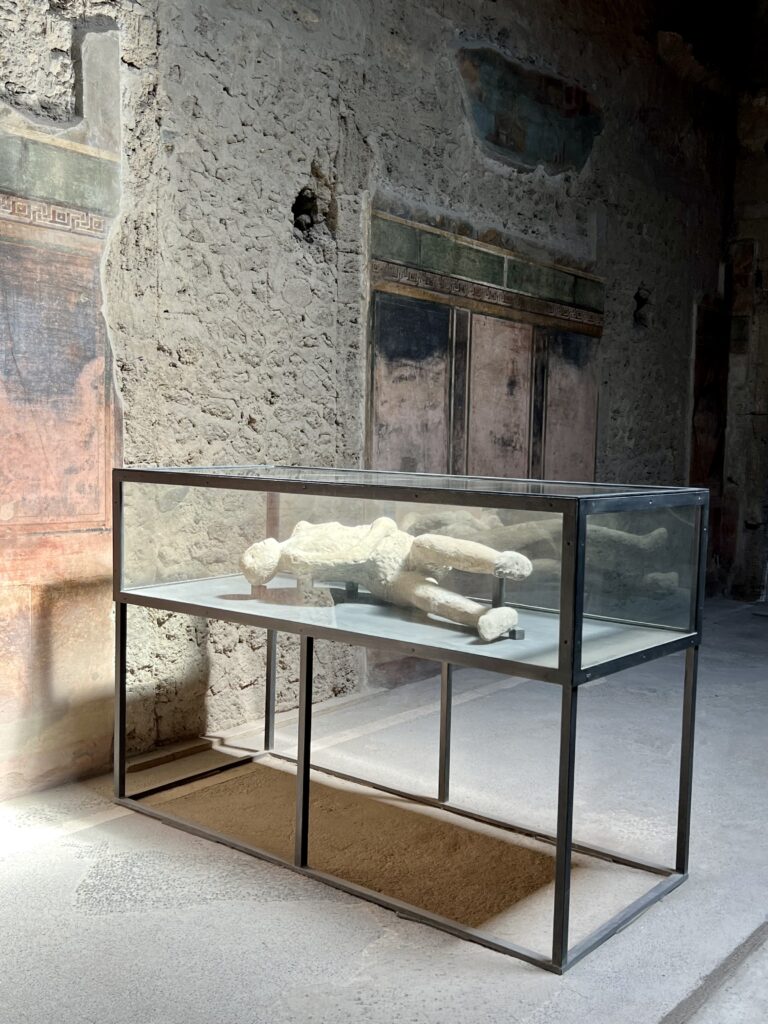
16. Preserved Plaster Casts
Scattered throughout Pompeii’s sites, you will see plaster casts. They are a poignant reminder of the human tragedy that unfolded in Pompeii.
The casts are the city’s residents, who were horrifically frozen in time by the volcanic ash. The casts were made by pouring plaster into the voids left behind by the decomposed bodies that were buried under layers of ash and pumice.
The process created molds to preserve their forms. They capture the final moments and final expressions of the victims.
You can find quite a few casts in the Stabian Baths, the macellum, and the granary of the forum. There are also many on display in the Garden of the Fugitives in the northeastern corner of Pompeii. You may need a map to find it.
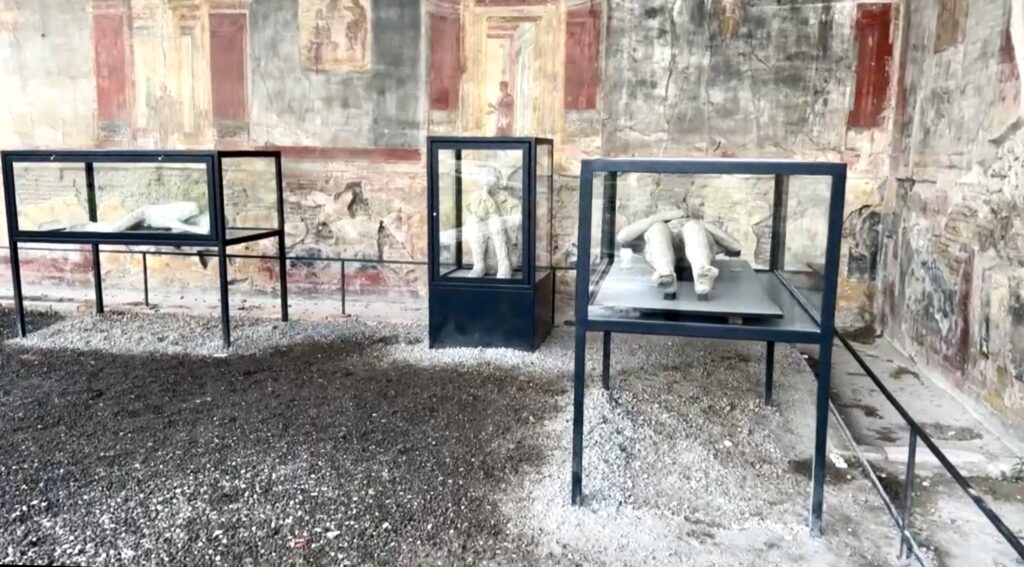
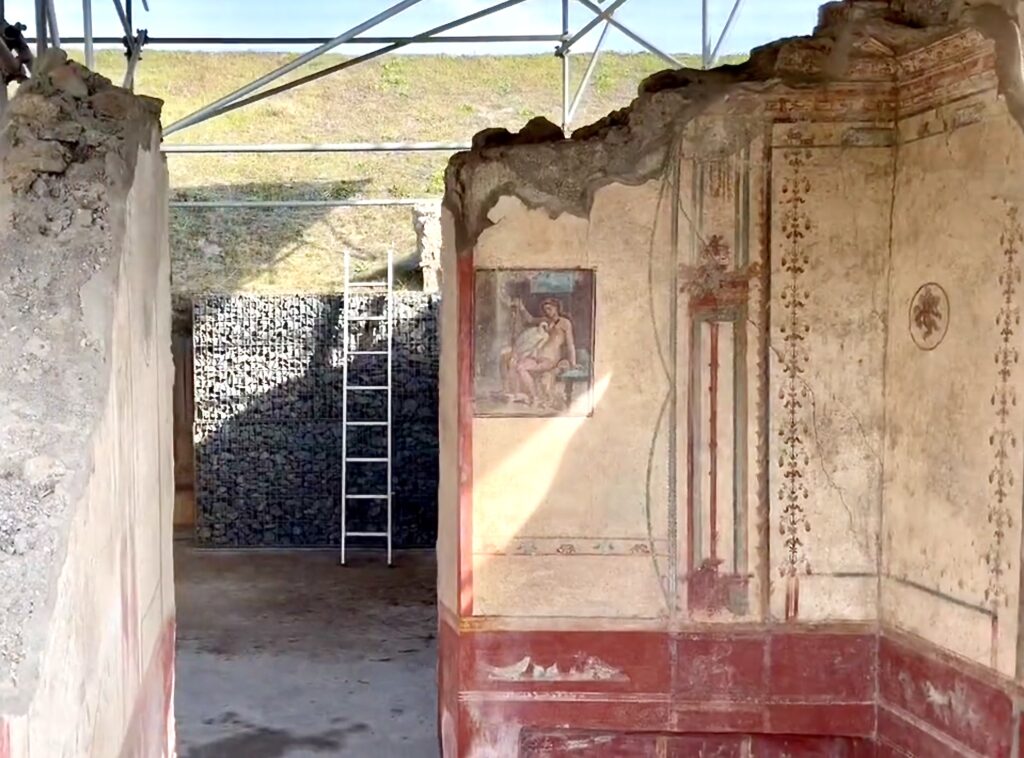
17. Regio V, Leda and the Swan
In 2018, a racy fresco was discovered during excavations at Pompeii’s Regio V area. Though tiny, it’s a very unique fresco. You can see it from the street.
It depicts the mythological event when Leda is raped by Zeus in the guise of a swan. As a result of their union, Leda gives bath to Helen, the women who launched the Trojan War.
The fresco has some unique features. First, Leda is portrayed sitting instead of standing. Second, she stares out at the viewers, making them a voyeur in her rape.
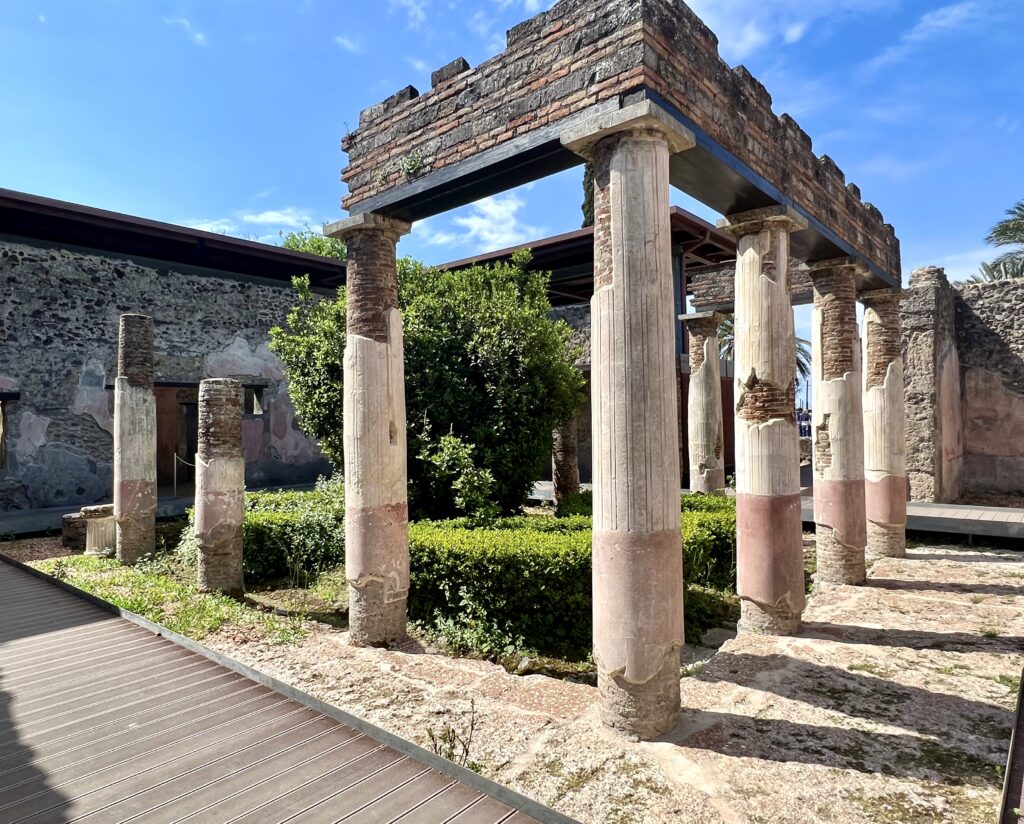
18. House of Diomedes
The House of Diomedes is located along the Via dei Sepolcri near the necropolis. It was built around 200 B.C. and belonged to various high ranking families.
The villa derives its name from graffiti mentioning Diomedes found on one of its walls. Diomedes was a wealthy citizen and, possibly, a notorious figure of criminal repute.
The house was one of the first things to be excavated in Pompeii. So, it attracted a large following of men on their grand tours of Europe in the 19th century.
The house consists of rooms arranged around a 14 column central atrium. Like many villas, it had an impluvium to collect rainwater.
18 women met their death inside the house, as they tried to flee from the eruption of Vesuvius. Their remains were discovered during excavations.
After restorations during the Great Pompeii Project, the domus opened to the public in September 2022.
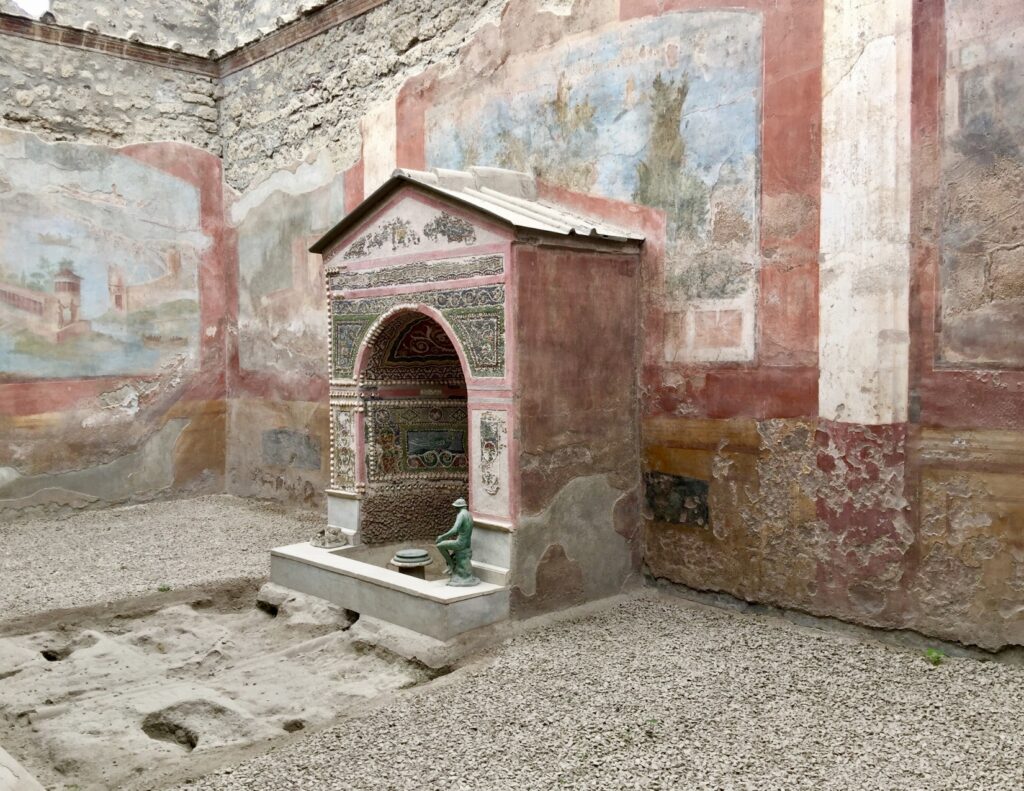
19. House of the Small Fountain
This is a small house that’s also worth a glance. it’s a middle class domus.
The house is know for the its beautiful mosaic fountain in the central courtyard or peristyle. The fountain is situated so that you can see it from the entrance.
The fountain has been restored. The side walls around it contain very faded frescos of landscapes and maritime buildings, which were probably in the 4th Pompeiian style.
The fountain has a miniature arch and triangular roof. There are tiny bronze statuettes on both sides.
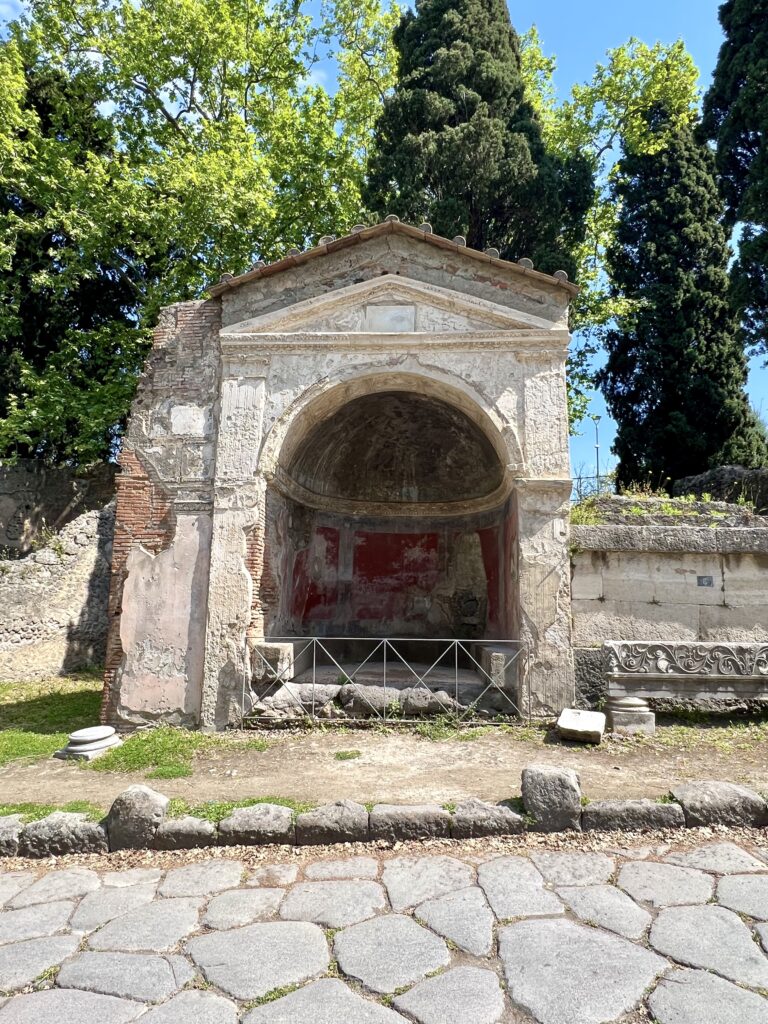
20. Necropolis
On your way to the Villa of Mysteries, you will pass down the tomb-lined Via dei Sepolcri known as the Street of Tombs. It’s an ancient burial ground located just outside the city limits, along the road that leads to Herculaneum.
This is where many citizens of Pompeii were buried. There are large range of burial tombs. Some are simple structures.
Other are ornate mausoleums, with intricate reliefs. Inscriptions prove some clues about who might be buried there.
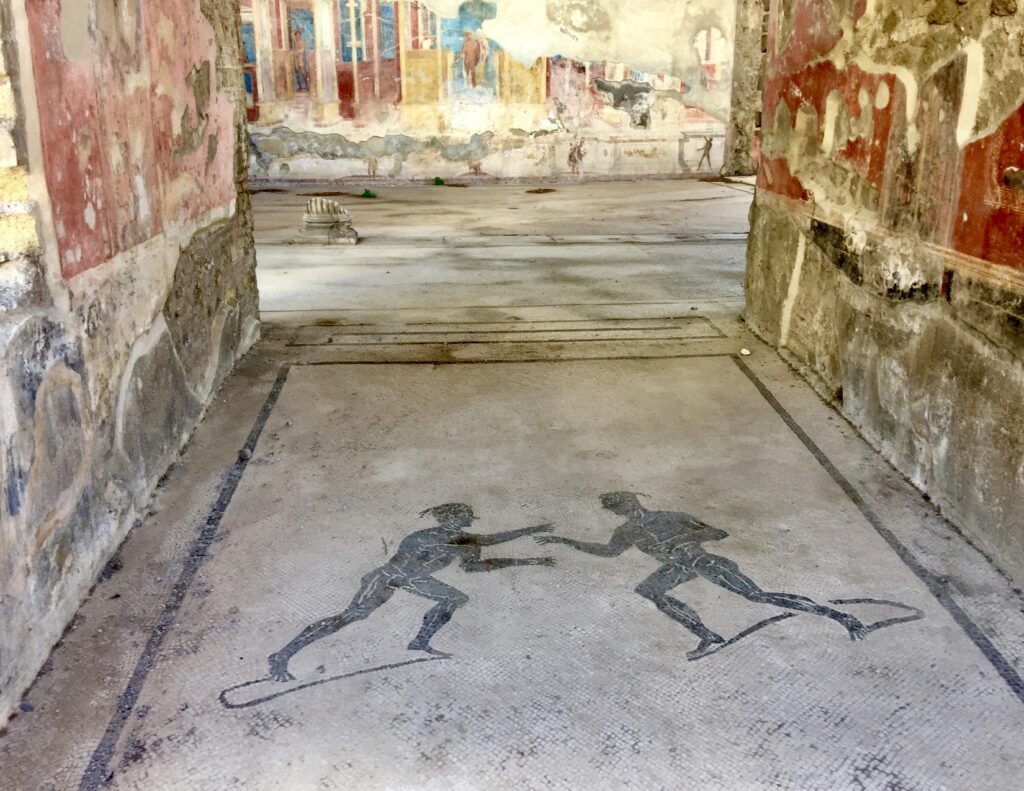
Practical Guide & Tips For Visiting Pompeii
Now, let’s get down to the nitty gritty. No guide to Pompeii would be complete without some must know tips for visiting this wondrous site. And I have quite a few for you.
1. How To Get To Pompeii
You can access Pompeii from Rome, Naples, or the Amalfi Coast. There are various ways to get to Pompeii, and I describe them below.
But a car gives you the most flexibility. You can leave whenever you want and are done exploring.
From Rome:
The easiest way to get from Rome to Naples is by train. You can catch a high speed train from Rome’s Termini or Tibertina train stations to Naples. This will take about one to 1.5 hours.
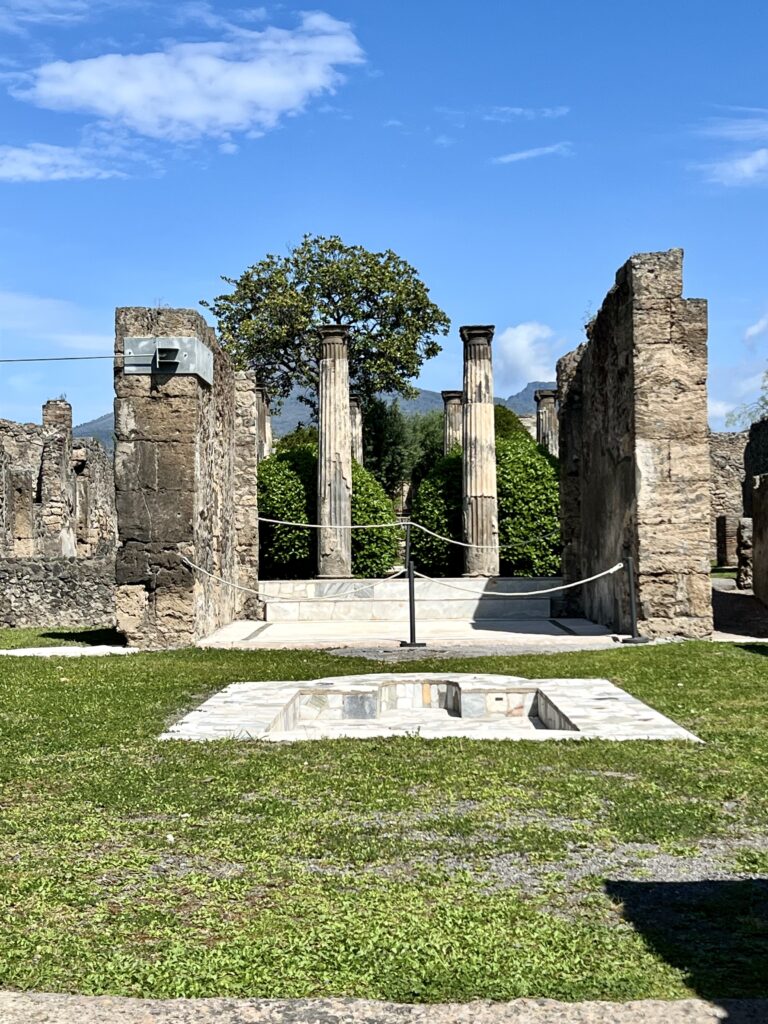
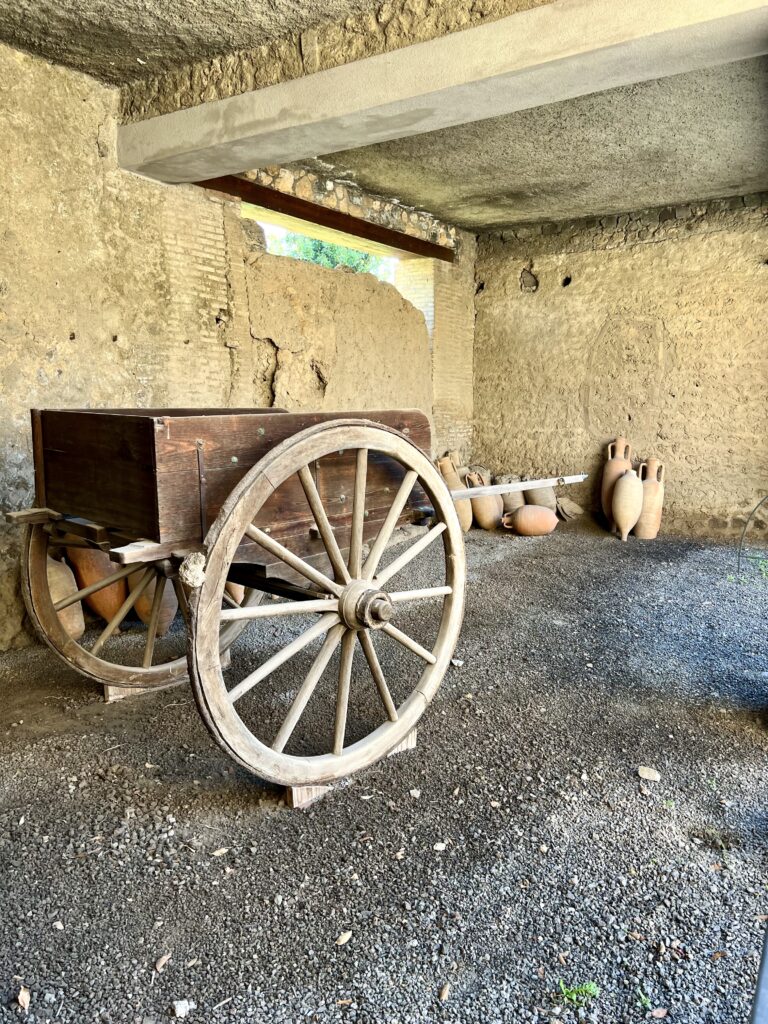
In Naples, you must transfer to a regional train in Naples’ Station Porta Nolana-Circumvesuviano and disembark at Pompeii’s Scavi-Villa dei Misteri.
The train will take about 30 minutes. The Pompeii train station is right next to the Porta Marina entrance to the archaeological site.
You can also take the bus (2-3 hours) or drive from Rome to Pompeii. Depending on traffic, driving will take about 2.5 hours. It’s 150 miles between the cities.
In addition, beginning on July 16, 2023, there will be a direct train service from Rome to Pompeii every third Sunday of the month. Passengers can watch a video about Pompeii and purchase tickets onboard.
And you can always book a guided day tour from Rome to Pompeii. This 13 hour guided tour gives you an overview of both Naples and Pompeii.
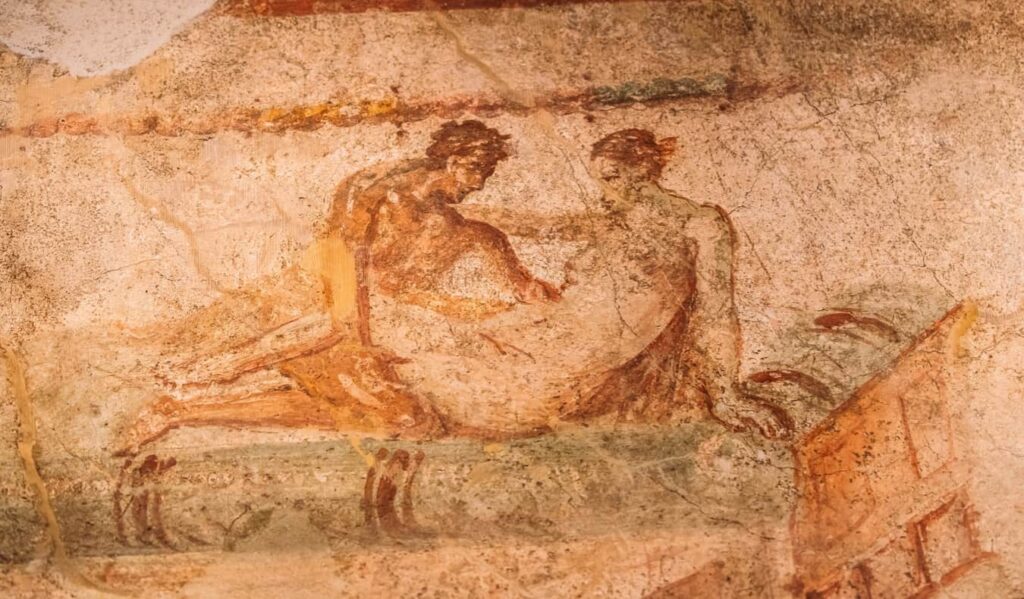
From Naples:
If you want to go by train fro Naples to Pompeii, it’s just 30 minutes. You take the Circumvesuviana train train from Napoli Centrale or from the Napoli Porta Nolana station.
You can also drive there in 30 minutes. There are parking lots near the archaeological site. But they can fill up fast in high season.
You can also book a private transfer from Naples, which is what I did and met my guide there. If you choose this option, you can have your driver drop you at the main entrance and pick you up near the Villa of Mysteries at a designated time.
Alternatively, from Naples, you can book a:
- guided full day tour that includes Pompeii and Vesuvius
- guided tour of Pompeii and the Amalfi Coast
- guided tour tour of Pompeii and Herculaneum with an archaeologist
From the Amalfi Coast:
If you want to visit Pompeii from the Amalfi Coast, you can catch a train from Sorrento. Or you can book a guided tour from Sorrento. You can also book a guided tour from Positano or one from Salerno.
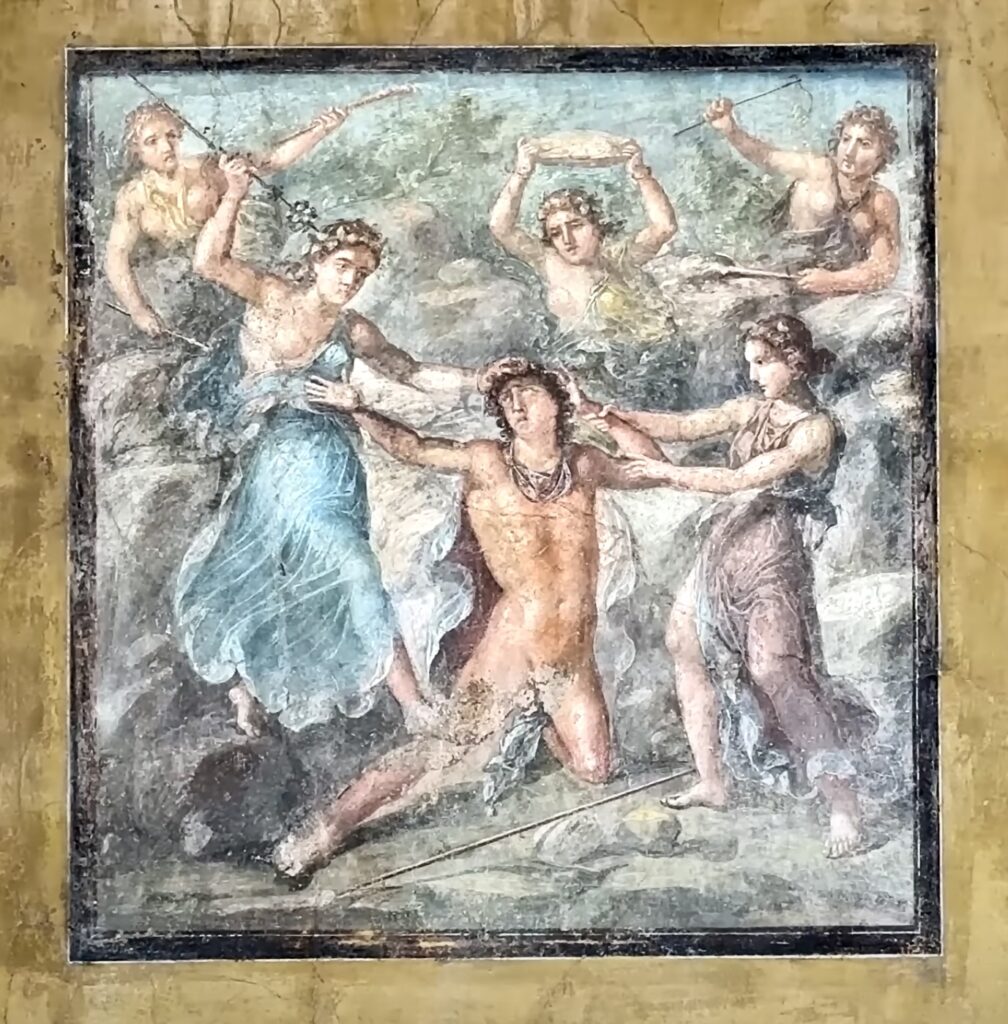
2. Tickets
To avoid waiting in line, you should book a skip the line ticket on Get Your Guide or a fast track ticket on Viator in advance.
Like other museums in Italy, Pompeii is free to visit on the first Sunday of the month. But you should expect heavy crowds.
3. Entrances
There are two primary entrances to the archaeological site. The first entrance is Porta Marina, located in the southwest, with the adjacent Piazza Esedra.
This entrance serves as the main gateway and offers convenient access to the major attractions within Pompeii. It’s also where you can obtain an audioguide.
Due to its proximity to the main points of interest, Porta Marina tends to be busier, especially during peak periods. Therefore, it’s advisable to anticipate potentially long queues for ticket purchases.
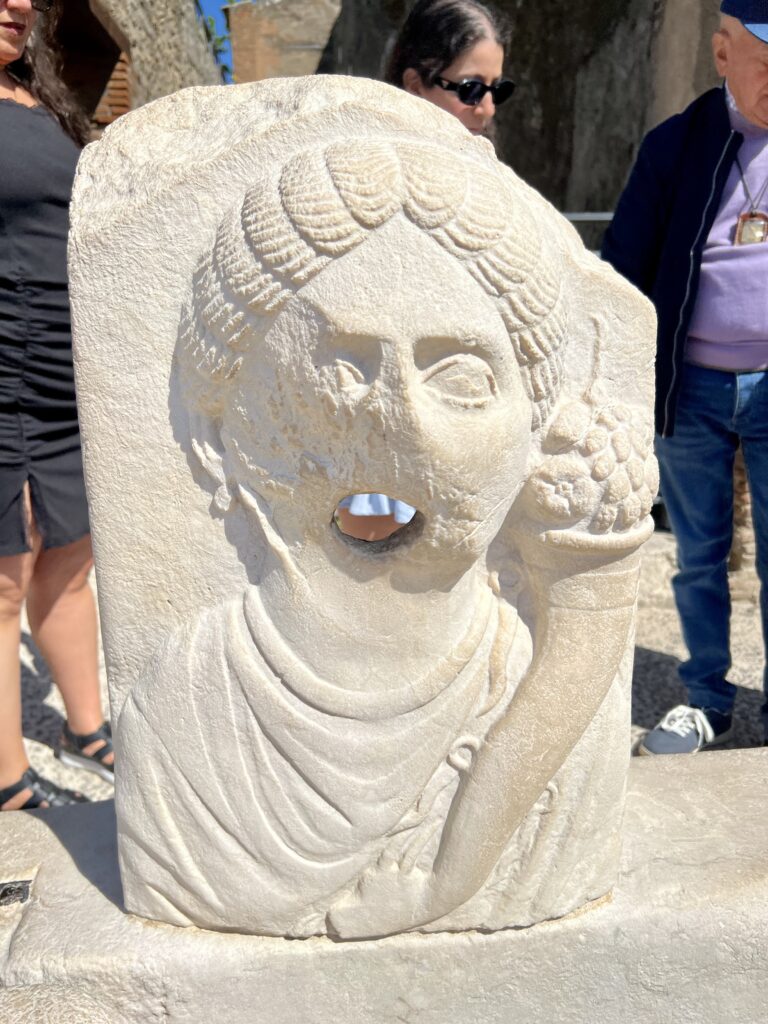
Alternatively, the second entrance is Piazza Anfiteatro, situated in the southeast of Pompeii.
While less crowded compared to Porta Marina, it still provides access to significant areas of the site, including the amphitheater. This entrance may be a suitable option for those seeking a quieter and more relaxed visit.
4. Opening Hours
From April 1 to October 31, Pompeii is open from 9:00 am to 7:00 pm. The last entry is at 5:30 pm. From November 1 to March 31, the site is open from 9:00 am to 5:00 pm with the last entry at 3:30 pm.
Be aware that, even though sites may be listed as open on the website, they may be closed when you visit. Or, they not be open for the entire time the archaeological site is open.
Things seem to close on whim sometimes. You will not necessarily know when and if restoration is being done.
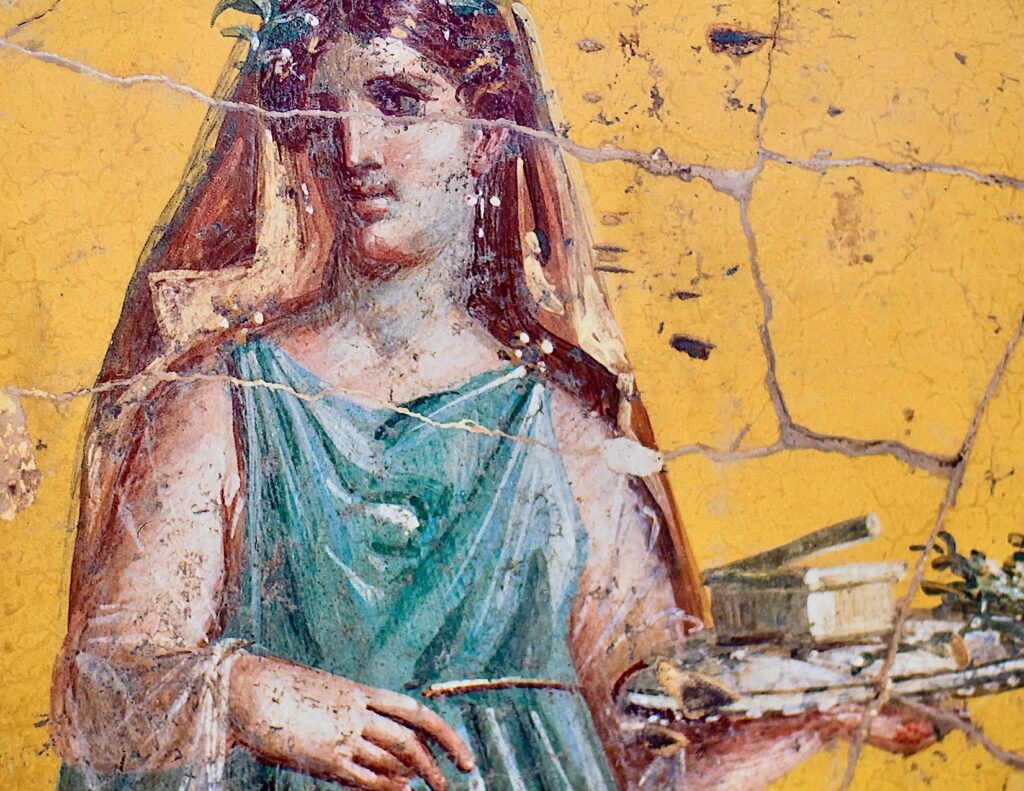
5. When Is The Best Time To Visit Pompeii?
Not on a weekend! Try to visit on a weekday or during the off season to avoid crowds at Pompeii
I also don’t think it’s best to arrive when Pompeii first opens. There will already be people waiting.
It’s better to visit in the mid afternoon during high season. By that time, some of the cruise ship visitors will have departed and the site will be quieter and less crowded.
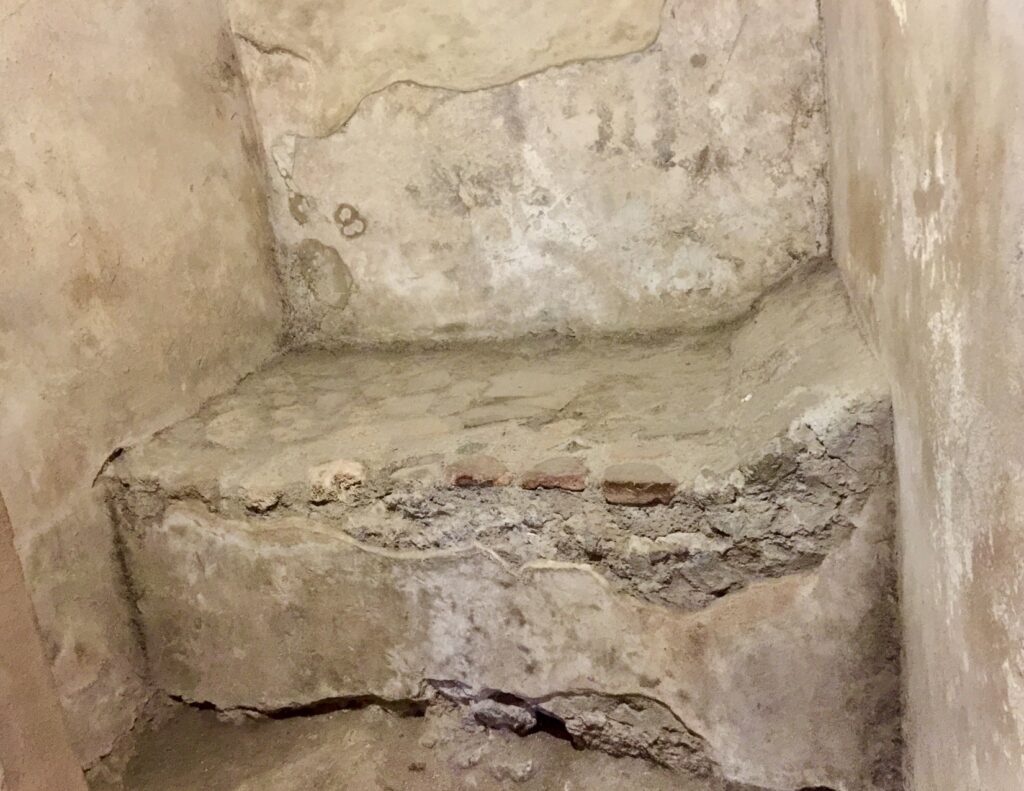
6. How Much Time Do You Need For Pompeii?
This depends on how much you like ancient history. But you could easily spend all day at the archaeological site.
Pompeii is a city after all. It sprawls out over a large area. For example, it takes a full half hour to walk from the amphitheater to the outlying Villa of Mysteries.
Most visitors only see the main attractions in the center on a quick tour. Try to concentrate on the main sites and don’t get bogged down on all the side streets.
While 2 hours may be all the time you have, I think Pompeii is better savored with a longer visit of 4-6 hours.
If you are already familiar with Roman theaters and forums from visiting other sites, I would instead focus on Pompeii’s star villas — the House of Menander, the House of the Vettii, and the House of the Mysteries.
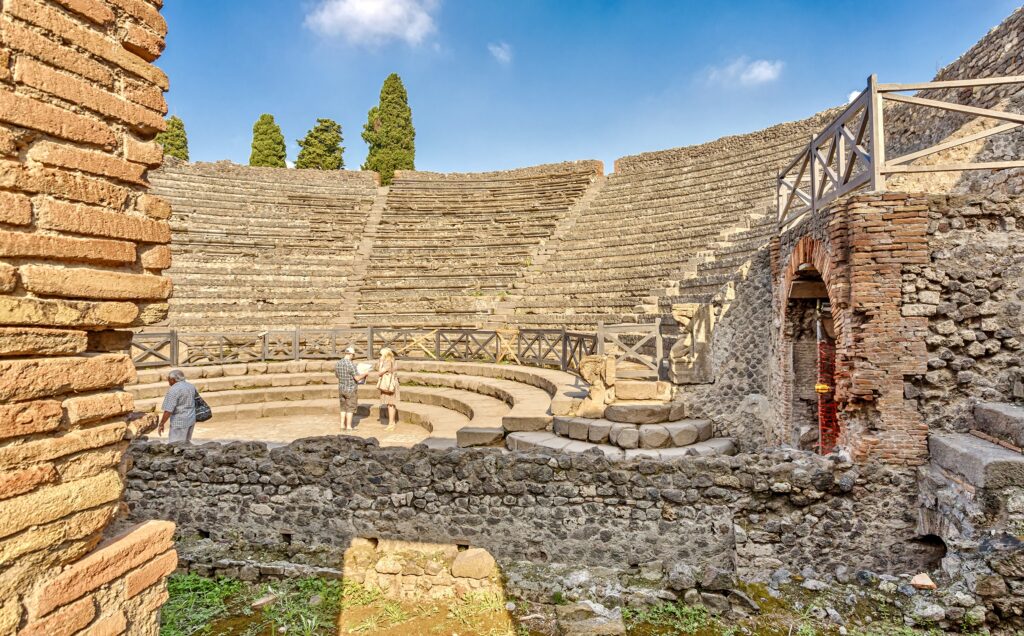
7. Proposed Pompeii Itinerary
If you are feeling ambitious and want to see as many sites as possible, here is an example of how you can proceed. Enter at the Marina Gate and turn right. Then, see these sites in the following order:
- Large Theater
- Small Theater
- House of Menander
- Palastra
- Amphitheater
- Walk down Via dell’Abbondanza
- Stabian Baths
- Brothel
- Forum of Pompeii
- Temple of Apollo
- Forum Baths
- House of the Tragic Poet
- House of the Faun
- House of the Vettii
- Villa of Diomedes
- Villa of the Mysteries
If you are shorter on time, you can eliminate the sites listed after the Forum Baths.
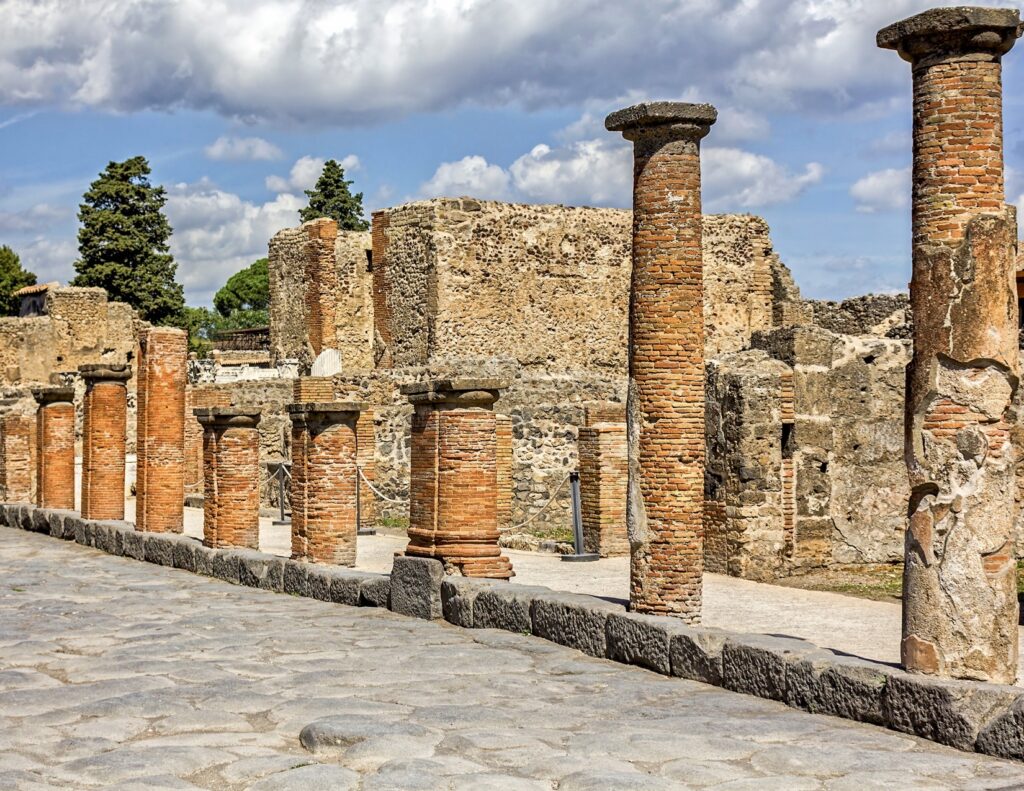
8. Pro Tips
To prepare for your visit to Pompeii, you may want to read the online booklet about the excavations. They’re divided by region. This will help you determine what to see.
On a practical note, Pompeii can be very hot. Be prepared with sunscreen and water bottles.
You should also wear comfy walking shores. You’ll be walling on uneven cobbled pavement the entire visit.
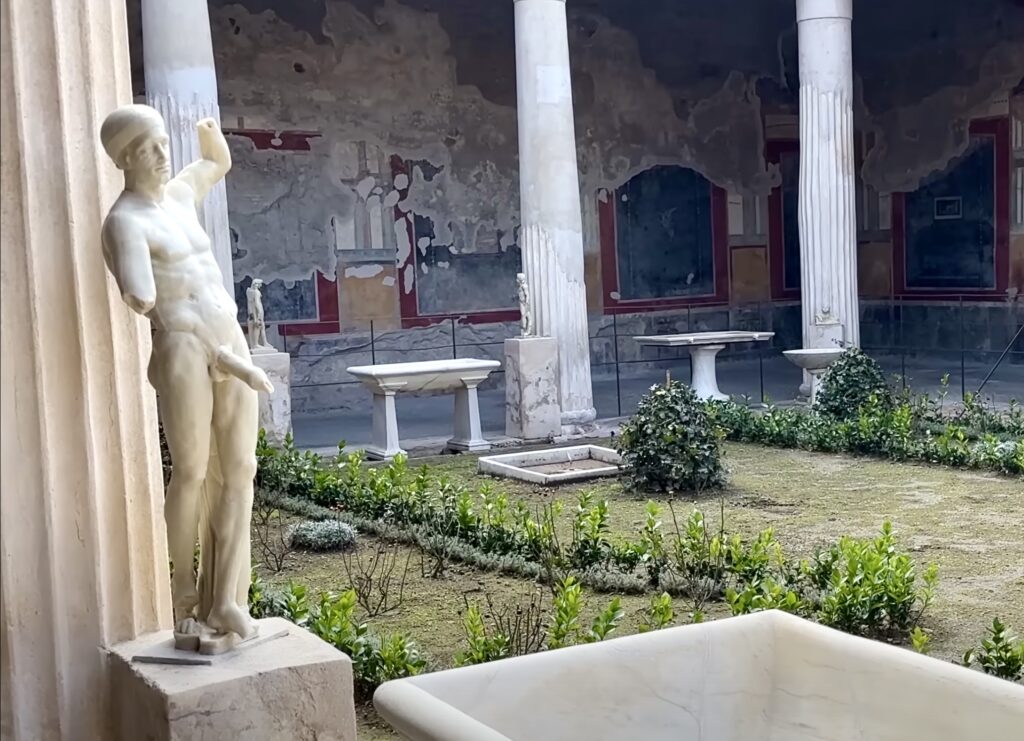
9. Where To Stay Near Pompeii
I can’t say that the town of Pompeii has much to recommend itself. Still, if you want to really take maximum advantage of seeing the ancient ruins, you may want to overnight in Pompeii.
I would check out the 4 star hotels in the area — Hotel Forum, Hotel Bosco De’ Medici, and Hotel del Sole.
If you are traveling from Naples, there are plenty of great places to stay. I can personally recommend the Eurostars Hotel Excelsior (5 star in Chiaia) and The Britannique Naples (Hilton Curio in Chiaia). Both hotels are in an upscale neighborhood with seaside views and near the metro.
You may also want to stay in Sorrento to access Pompeii. I stayed on the edge of town at the lovely Grand Hotel Cocumella.
You can also check out the Grand Hotel Excelsior Vittoria and the Palazzo Marziale. They are luxury hotels in lovely historic buildings.
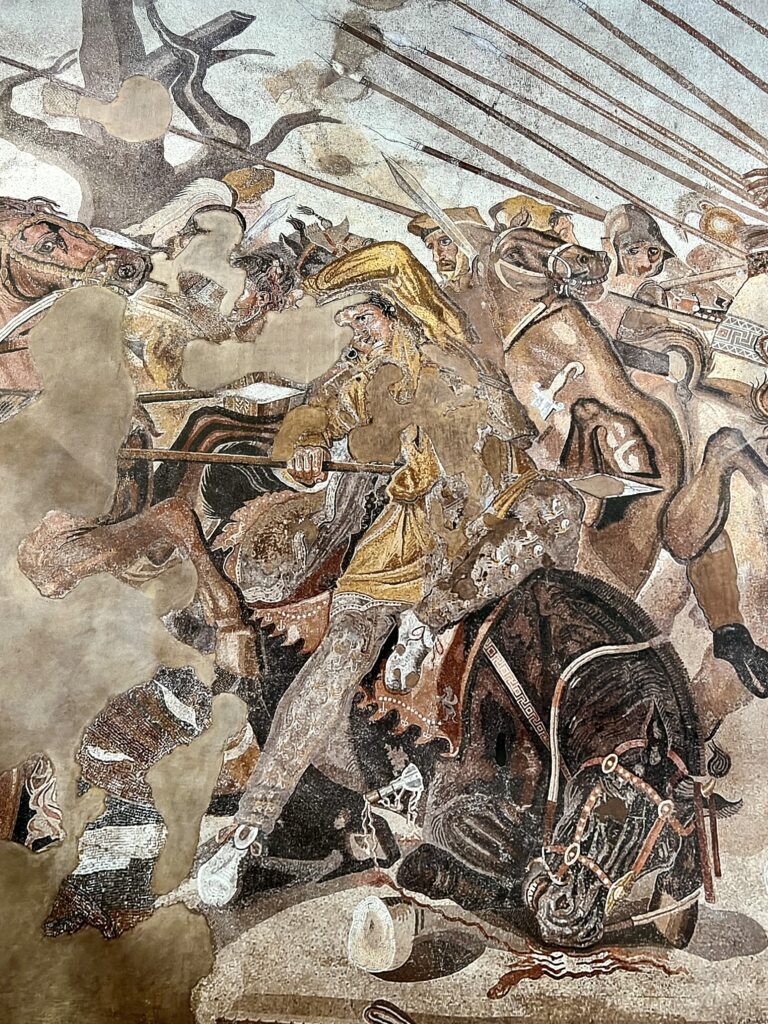
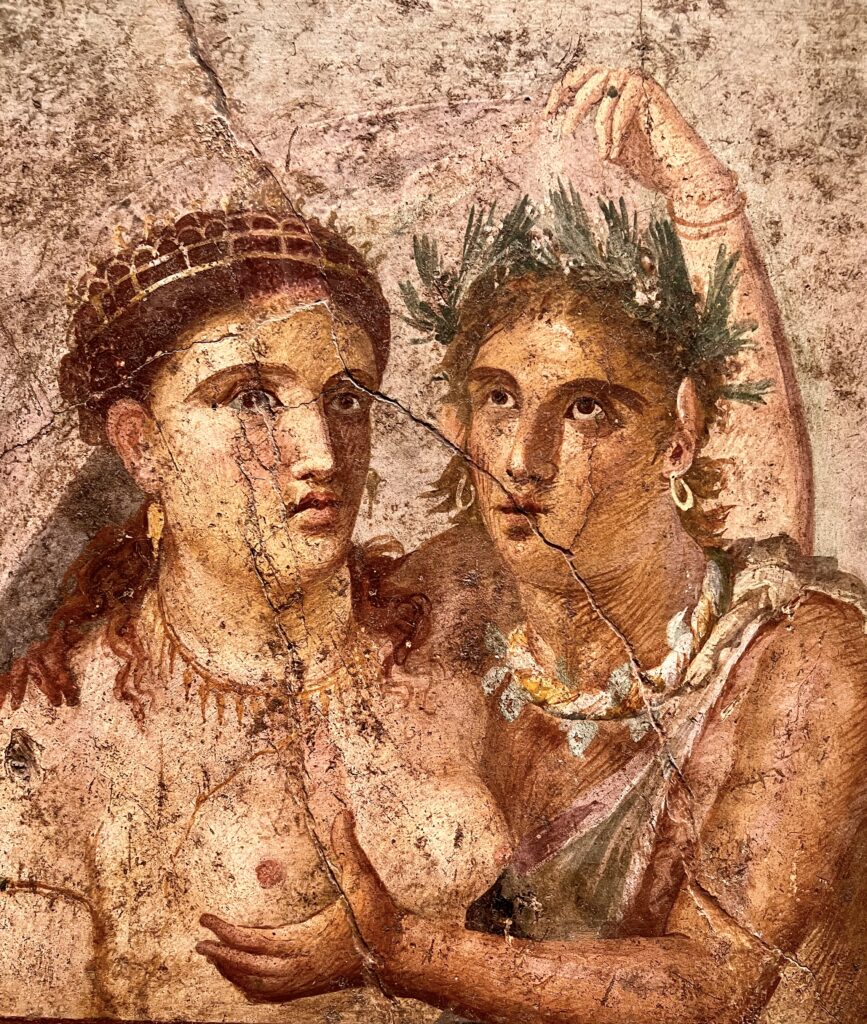
10. Naples National Archaeological Museum
As I mentioned, most of the actual treasures excavated from Pompeii are found in the Museo Archeologico Nazionale di Napoli.
This is a fantastic one-of-a-kind museum located in Naples’ centro storico. You’ll find a huge cache of frescos and mosaics from Pompeii, along with Roman statuary from the Farnese collection.
Ideally, you should visit the museum first before visiting the ruins of Pompeii. That way, you’ll have an idea of what the city once looked like in its glory days.
In high season (May to September), I advise booking a skip the line ticket for the museum. This is an extremely popular place. I took this private tour of the museum with an archaeologist and loved it.
I hope you’ve enjoyed my guide to visiting Pompeii. You may enjoy these other Italy travel guides and resources:
- 3 day itinerary for Rome
- 5 day itinerary for Rome
- 1 day itinerary for Vatican City
- 3 day itinerary for Florence
- 2 day itinerary for Venice
- 1 day itinerary for Milan
- 1 day itinerary for Siena
- One week in Umbria
- 10 days in Italy itinerary
- 10 day itinerary for Tuscany
- 12 ways to spend 1 week in Italy
- 2 weeks in Sicily itinerary
If you need a guide to Pompeii, pin it for later.

